You are using an out of date browser. It may not display this or other websites correctly.
You should upgrade or use an alternative browser.
You should upgrade or use an alternative browser.
FiiO FD7
- Added by Ichos
- Create date
- Updated
Moonstar
100+ Head-Fier
Pros: Very Natural & Balanced Presentation,
Highly Controlled & Fast Bass Response,
Transparent, Detailed & Somewhat Organic Midrange Character,
Airy, Lively and Fatigue free Treble Tuning with Good Sense of Resolution,
Holographic Soundstage,
Beautiful Design & Solid Build Quality,
Rich Accessory & Features Package (Interchangeable Audio Jacks & Sound Tubes)
Highly Controlled & Fast Bass Response,
Transparent, Detailed & Somewhat Organic Midrange Character,
Airy, Lively and Fatigue free Treble Tuning with Good Sense of Resolution,
Holographic Soundstage,
Beautiful Design & Solid Build Quality,
Rich Accessory & Features Package (Interchangeable Audio Jacks & Sound Tubes)
Cons: Needs a Source with good Amplification (DAP M11 Pro, DAC/AMP Q5s) to show its real potential,
Not ideal for Bass-Heads,
Average Passive Isolation,
Long Burn-In Period,
Carry case looks fancy but could be slightly bigger (Pelican Case Could be better)
Not ideal for Bass-Heads,
Average Passive Isolation,
Long Burn-In Period,
Carry case looks fancy but could be slightly bigger (Pelican Case Could be better)
FiiO FD7 Pure Beryllium Diaphragm Dynamic Driver IEM Review
Introduction:
FiiO announced last year in August their Brand New Dynamic Driver Flagship IEM the FD7 together with the FDX, which is their 14th Anniversary Limited (Collector’s) Edition In-Ear Monitor. The FD7 features a top tier Single Dynamic Driver with a 12mm Pure Beryllium Diaphragm and utilizes a front acoustic prism & semi-open acoustic design. Moreover, it comes with an anti-standing wave “volcanic field” system and offers 3 pairs of interchangeable sound tubes.
- Product Website: FiiO FD7 IEM

Disclaimer:
I would like to thank FiiO for providing the FiiO FD7 as review sample. I am not affiliated with FiiO beyond this review and all these words are reflecting my true and unaltered opinions about the product.
Price & Availability:
The actual price of the FiiO FD7 is 599,99 USD, which is pretty attractive compared to other IEM’s with Pure Beryllium Diaphragm Dynamic Driver, for example the Final Audio A8000 (1.999 USD) and the Dunu Luna (1.699 USD), especially if you are curious about a product with this type of driver technology.
More information’s can be found under the link below;
Package & Accessories:
The packaging of the FD7 looks pretty similar to those of the FD5 that came also inside a rectangular black box that shows the product illustration and the motto of the company, which is “Born for Music“ on the top.

This box has been wrapped with a fancy cardboard sleeve that features some product related brandings and the illustration of the FD7 on the top.
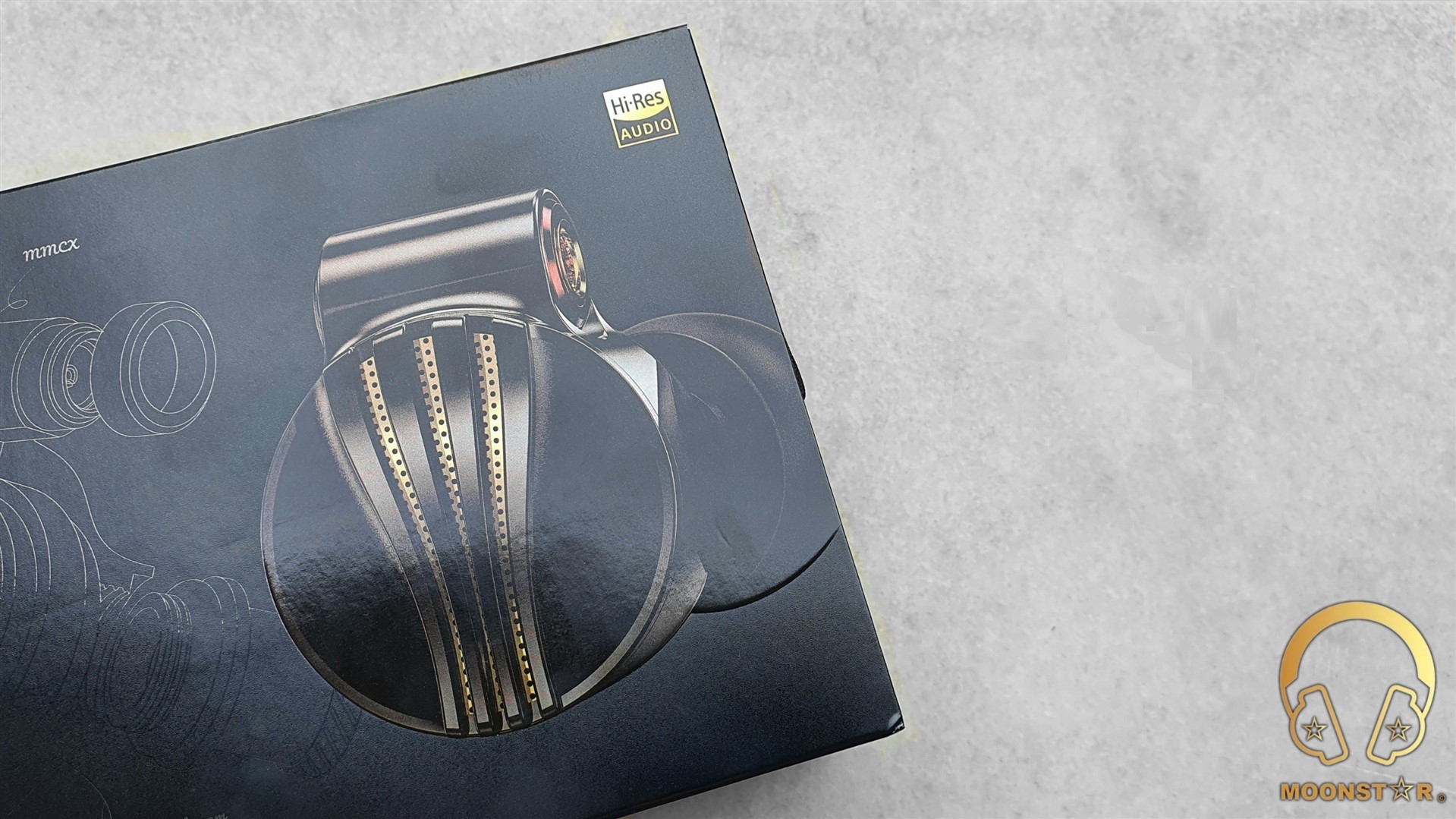
Inside the box are the following contents/accessories;
- 1 pair x FiiO FD7 In-Ear Monitors
- 1 pcs x Detachable cable with MMCX connectors
- 3 pcs x Interchangeable Headphone Jacks (3.5mm SE, 2.5mm Balanced, 4.4mm Balanced)
- 3 pcs x Interchangeable Sound Tubes (Bass, Balanced, Treble)
- 3 pairs x Bass Ear tips
- 3 pairs x Vocal Ear tips
- 3 pairs x Balanced Ear tips (1 pair came preinstalled)
- 2 pairs x SpinFit Silicone Ear tips
- 2 pairs x Triple Flange Silicone Ear tips
- 2 pairs x Memory Foam Ear Tips
- 1 piece x HB5 Storage Case
- 1 piece x Cleaning Brush
- 1 piece x SK1 Magnetic Cable Organizer (can also be purchased here separately)
- 1 piece x FiiO MMCX Assist Tool
- 1 piece x Warranty Card and User Manual

The FiiO FD7 offers a very rich ear tips collection that is placed in a foam layer that shows some short descriptions about the sound effects and the size of the tips. The collections includes 3 pairs of SpinFit silicone tips (S/M/L), 3 pairs of balanced ear tips (S/M/L size), 3 pairs of vocal ear tips (S/M/L size), 3 pairs of bass ear tips (S/M/L size), 2 pairs of memory foam ear tips (M/M/ size) and 2 pairs of Bi-Flange ear tips (M Size).
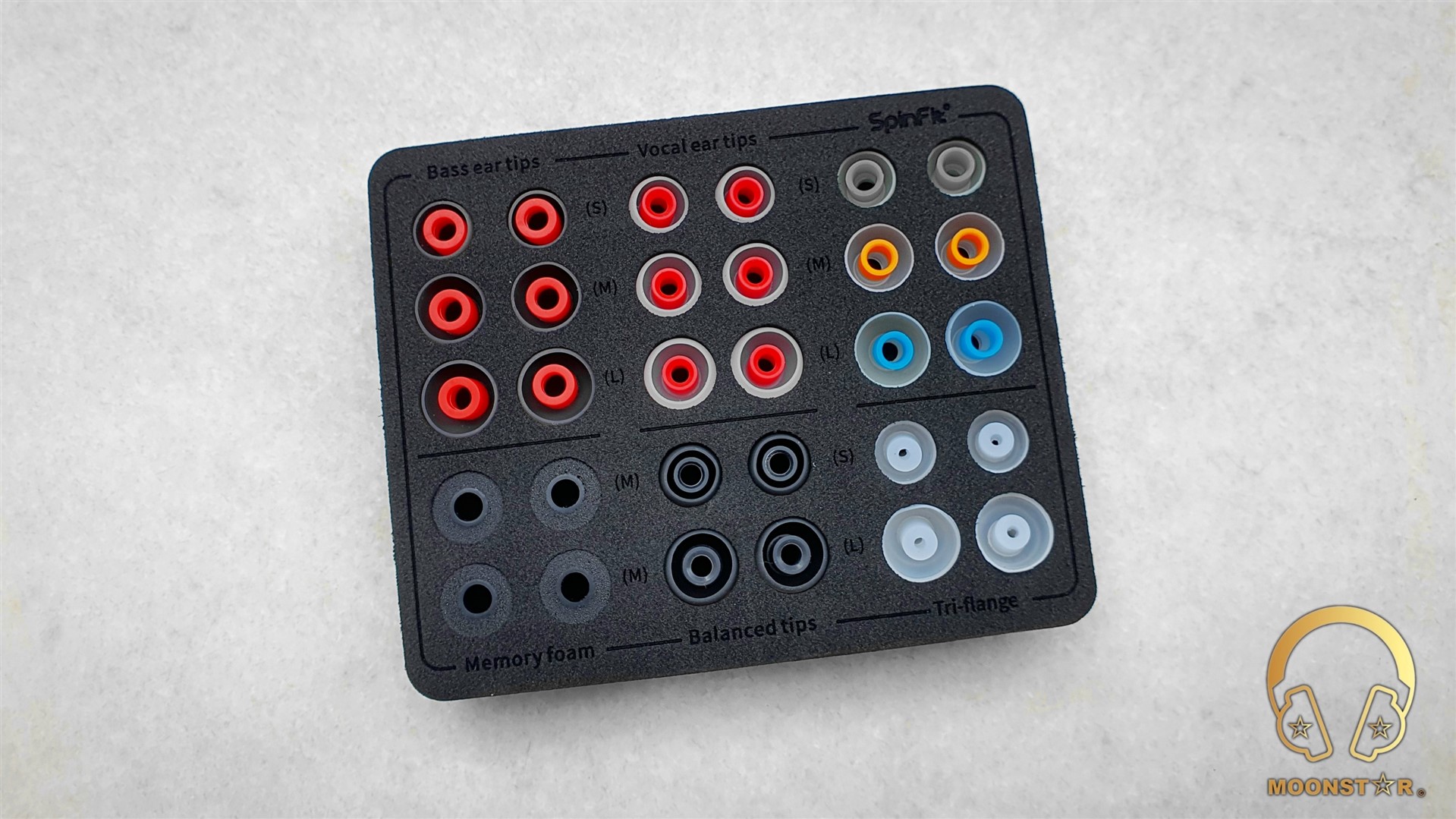
The HB5 storage case is another highlight of the FD7, which has a pretty luxurious appearance.


The accessories package includes also some useful additions such like the SK1 Magnetic Cable Organizer, a cleaning brush and FiiO’s new MMCX Assist Tool.
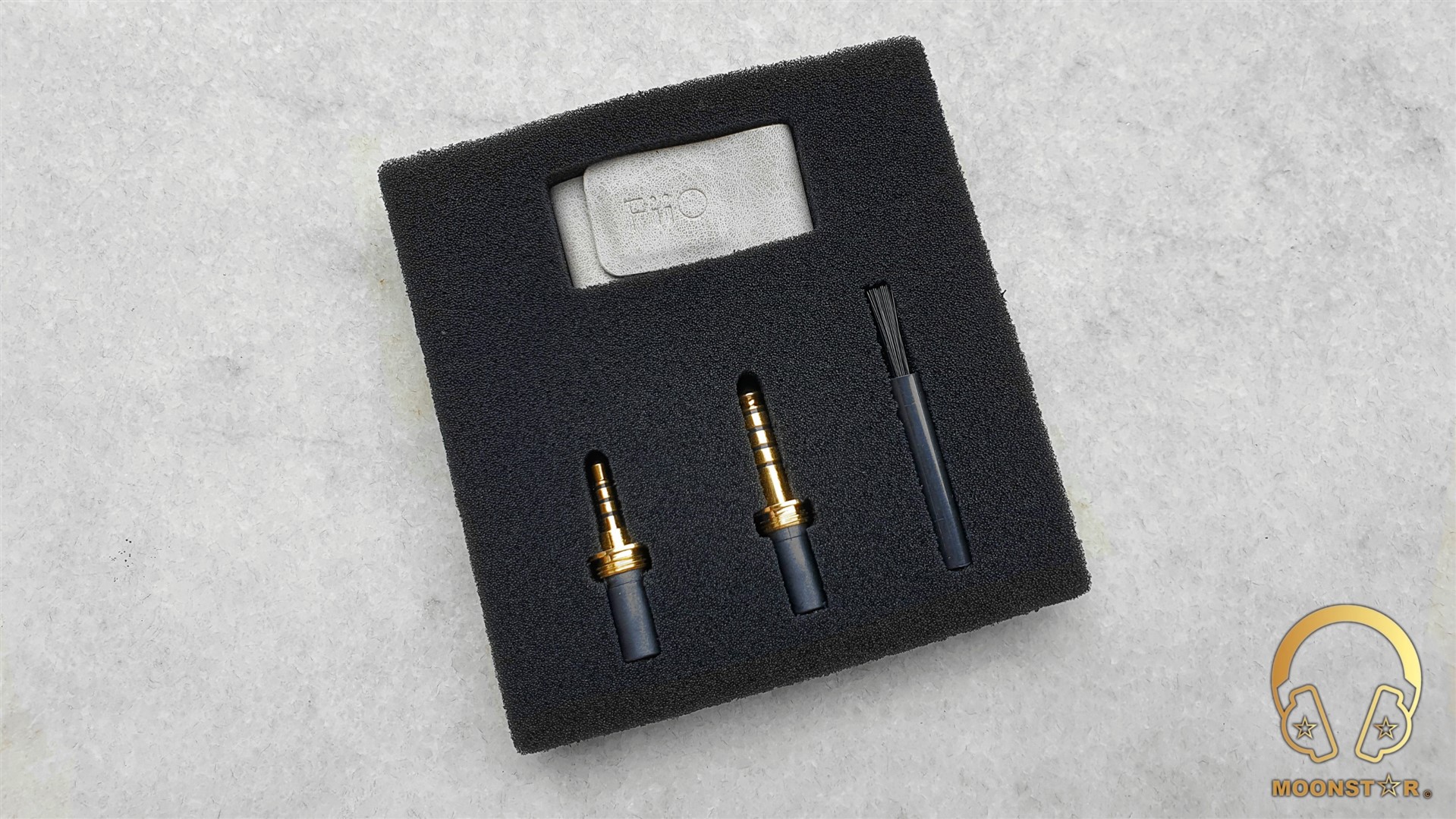
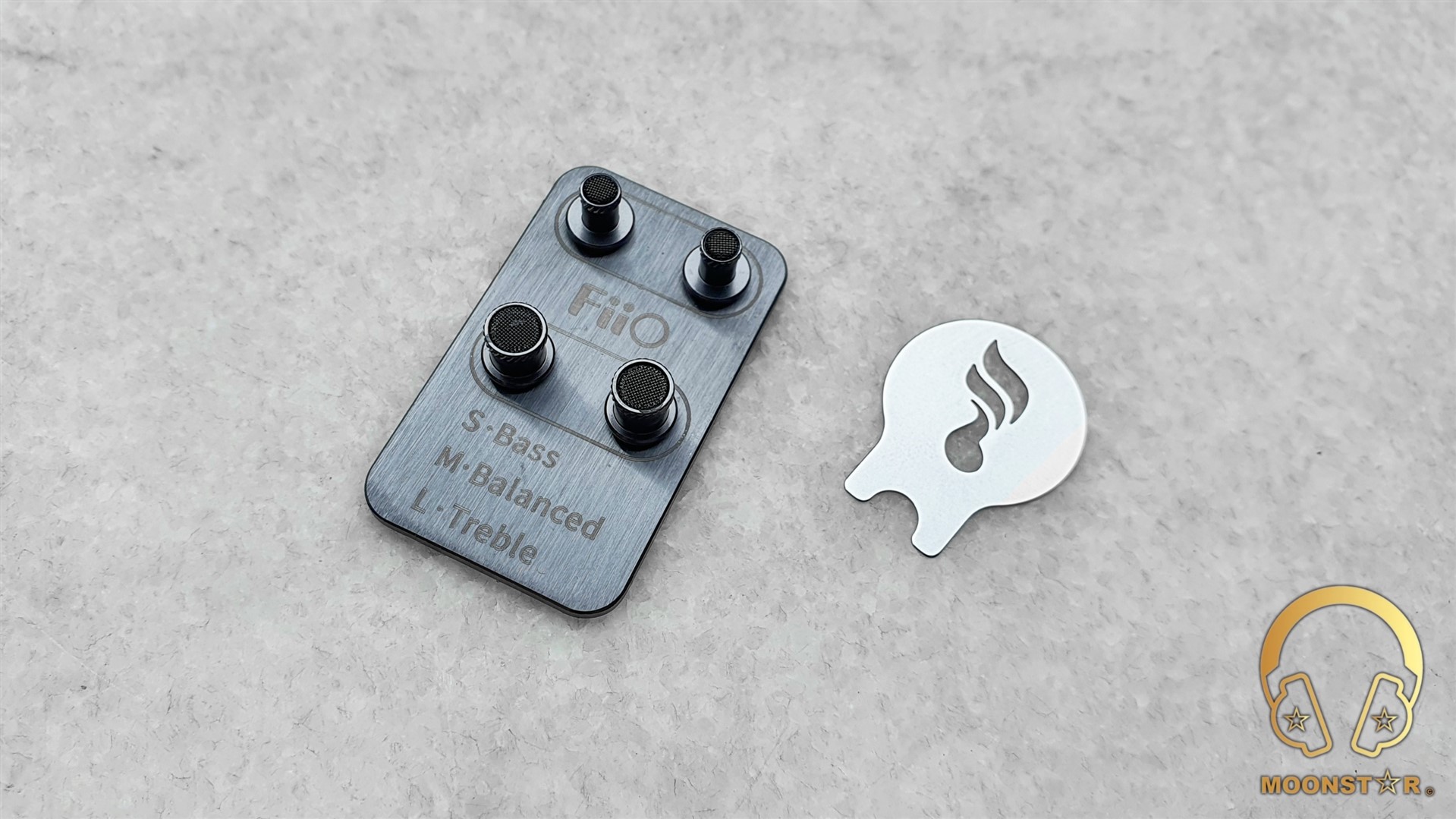
Design & Build Quality:
The FD7 is a solid looking In-Ear Monitor with its rigid monitor shell made of metal material in combination with a black finish. The appearance is pretty similar to those of the FD5, which was the first IEM of the company that had such a cylindrical shaped design. The FD7 does in fact implement many of the design elements we saw on the FD5 and takes them further, such like the semi-open & front acoustic prism design, volcanic field and many more.

The color scheme of the FD7 reflects the Chinese landscape paintings such like gold flake rivers and vast black mountains. On the front is the faceplate of the FiiO FD7 with its semi open back design and the so-called volcanic field system behind it.
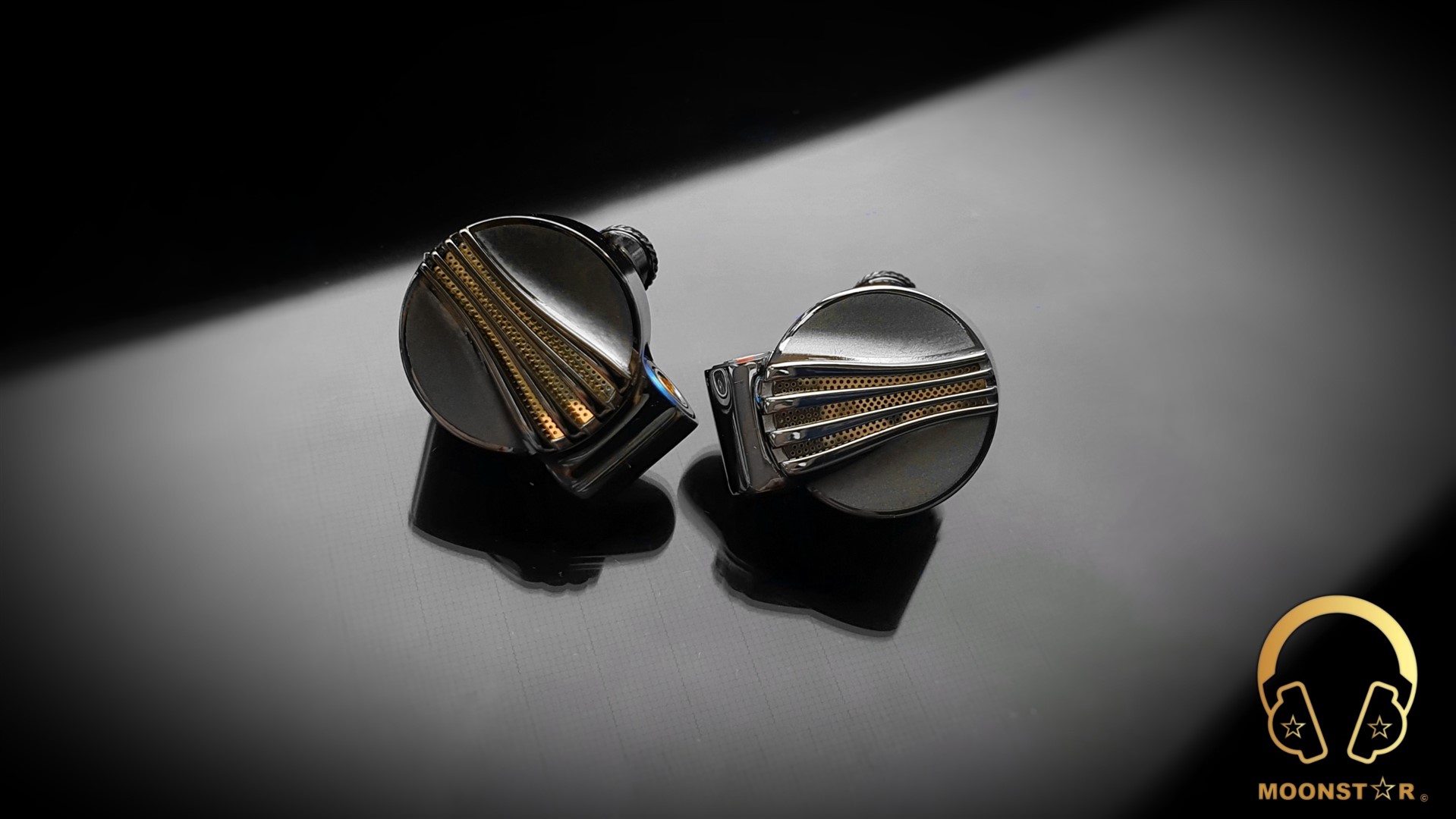
The rear part has a curved cylindrical shape same like the FD5, FD3/FD3 Pro and the FA7S.
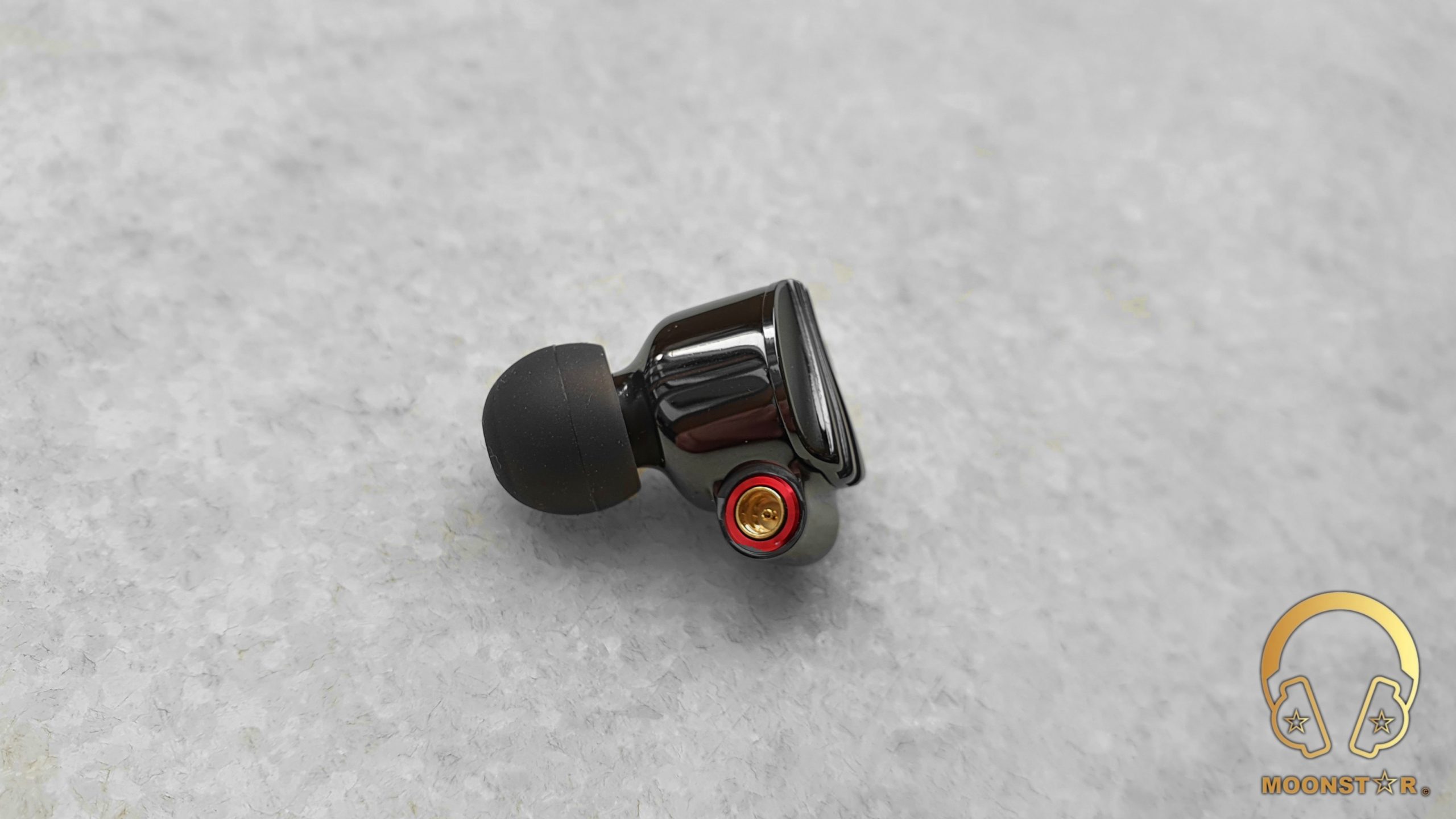
Here are the L (Left) & R (Right) markings and a small vent for the huge 12mm diameter Dynamic Driver that is located near the unscrewable sound nozzle area.
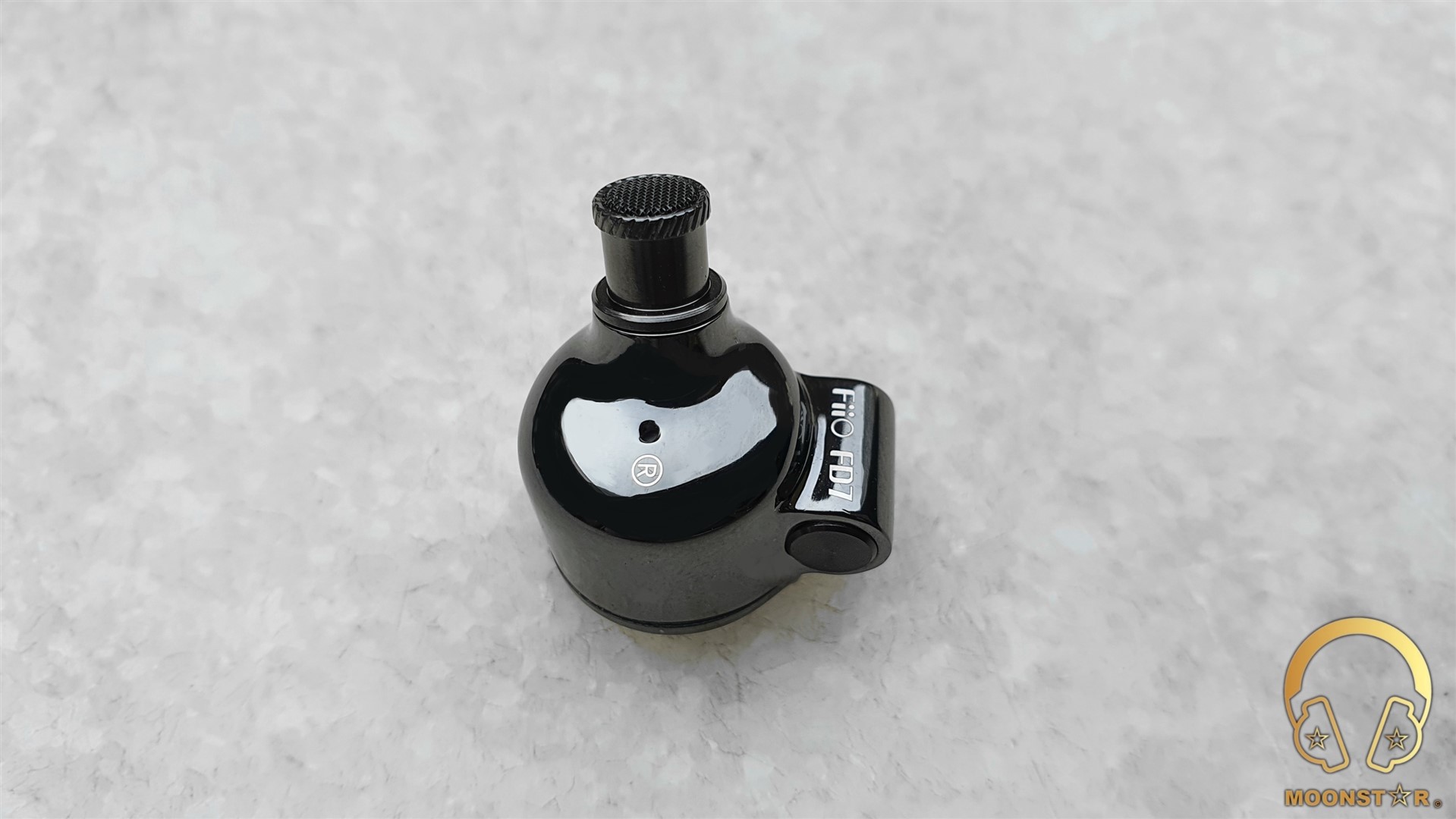
The monitor sports a protruding part with the MMCX (Micro Miniature Coaxial) female connectors on the top. The left MMCX female connector has a blue and the one on the right monitor has a red color indicator.
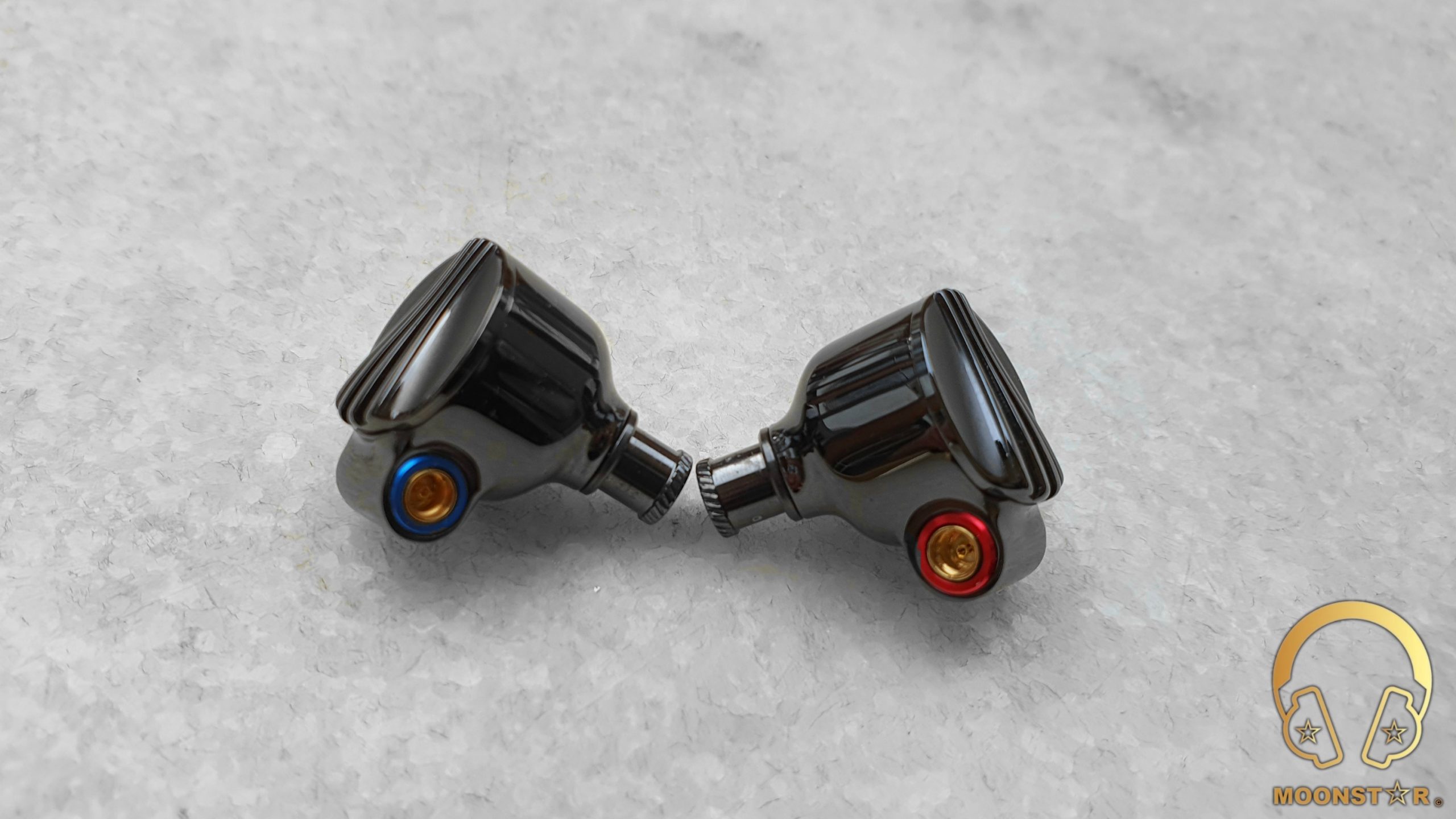
The sound nozzle has an “Interchangeable Sound Tube” design same as the one we have seen on the FD5.
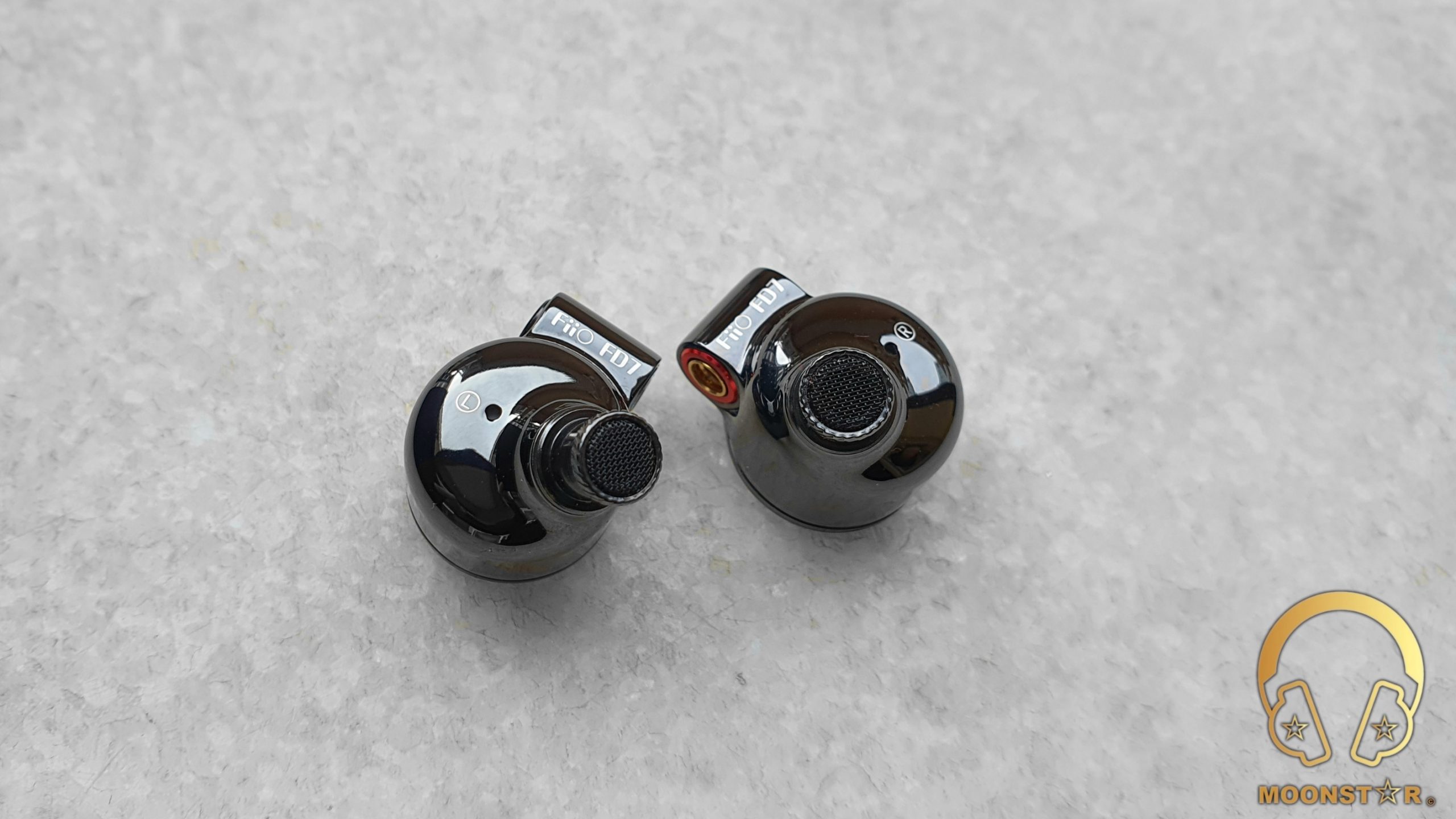
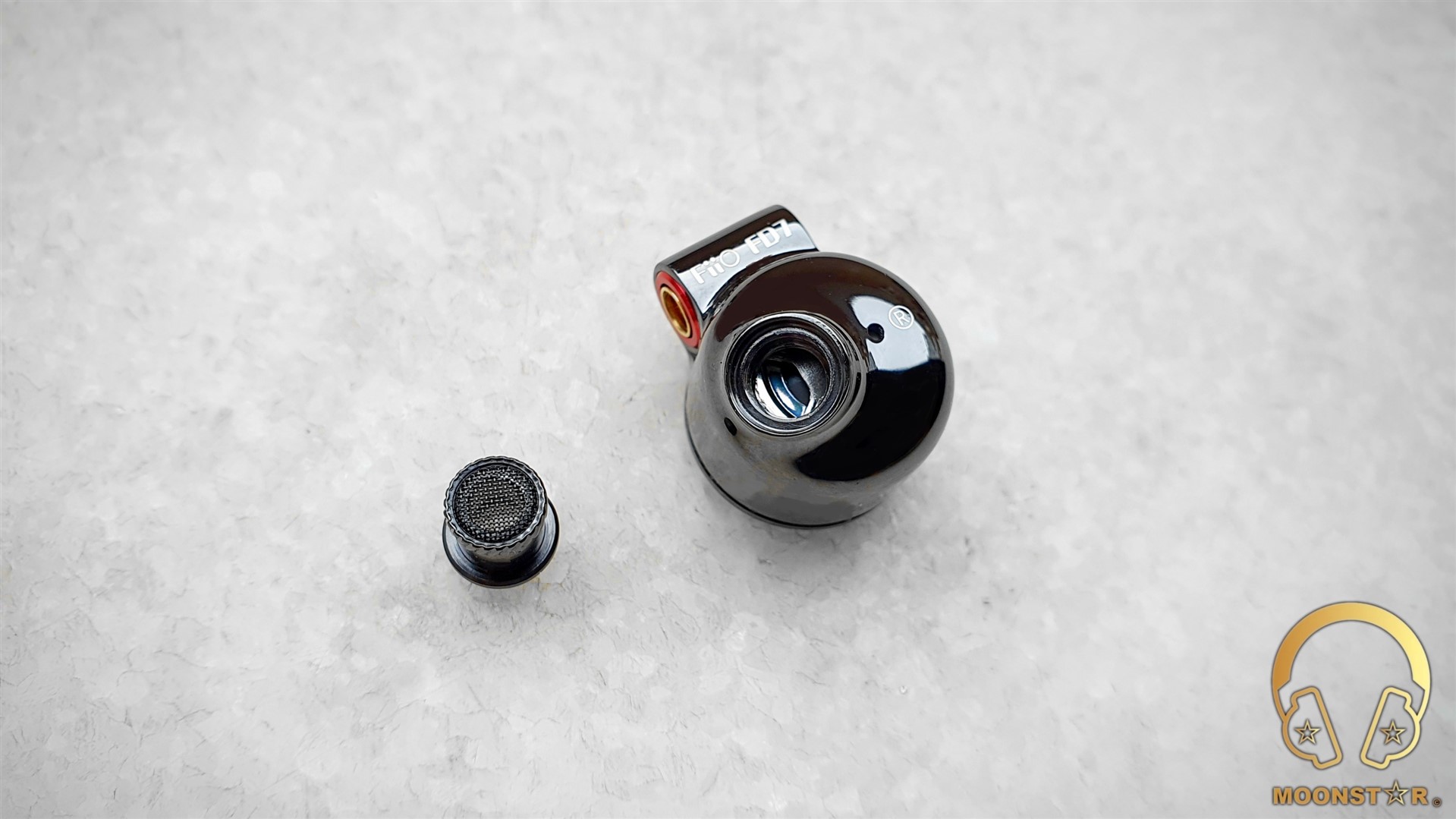
The FD7 comes this time with 3 different Interchangeable Sound Tubes, which are Bass, Balanced and Treble. The treble tube has the largest diameter, while the Bass tube has the smallest diameter.

Detachable Cable:
The FiiO FD7 comes with a high quality 4 core detachable cable made of 224 strands of high-purity Monocrystalline Silver wires.

The cable has a Litz braided design that features an environmental friendly medical grade TPU insulation with very low amount of microphonic effect.

The FD7 utilizes angled expanded MMCX connectors, which went through many ergonomic iterations and improvements, in order to achieve maximum comfort.
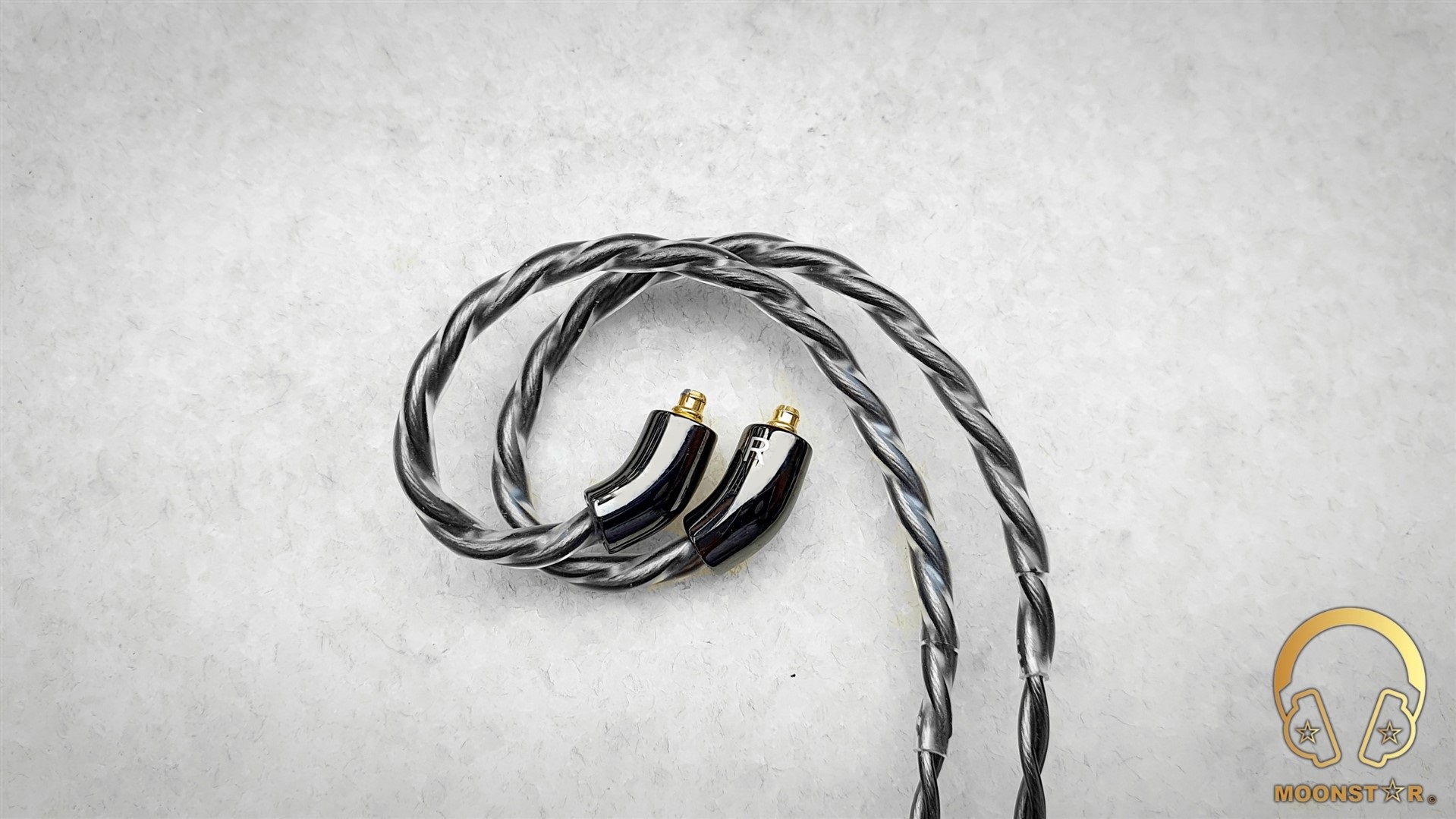
The cable features a metal Y splitter with the FiiO branding on the top and comes with a metal chin slider made of the same metal material in black (gunmetal) color.
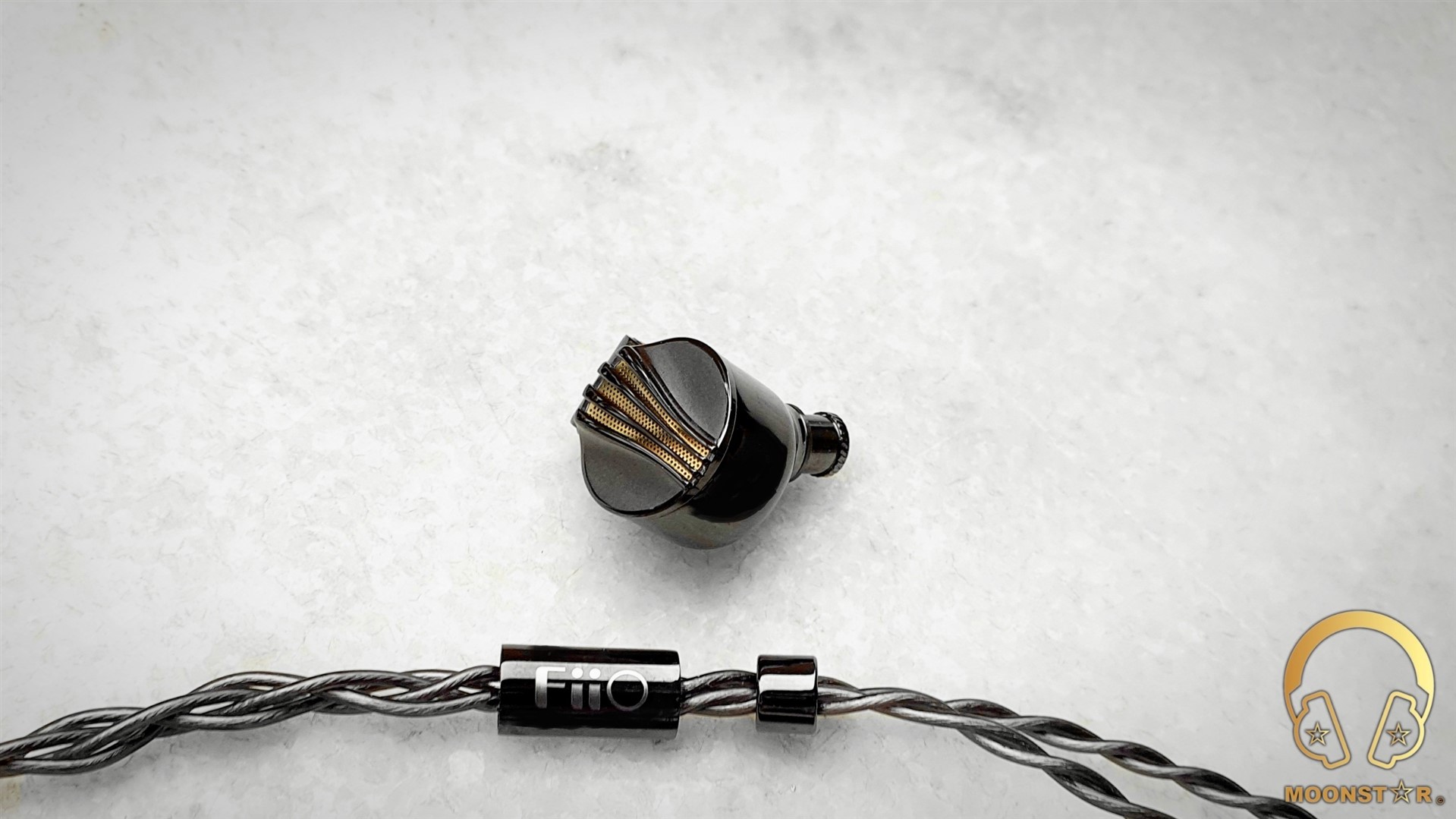
The detachable cable comes with an Interchangeable Headphone Plug that has a unique twist and lock mechanism same like the one we have seen on the FD5. It offers 3 (three) plug variants, which are the 3.5mm Single Ended (TRS) plug, 2.5mm Balanced (TRRS) plug and the 4.4mm Balanced (TRRRS) Pentaconn plug.
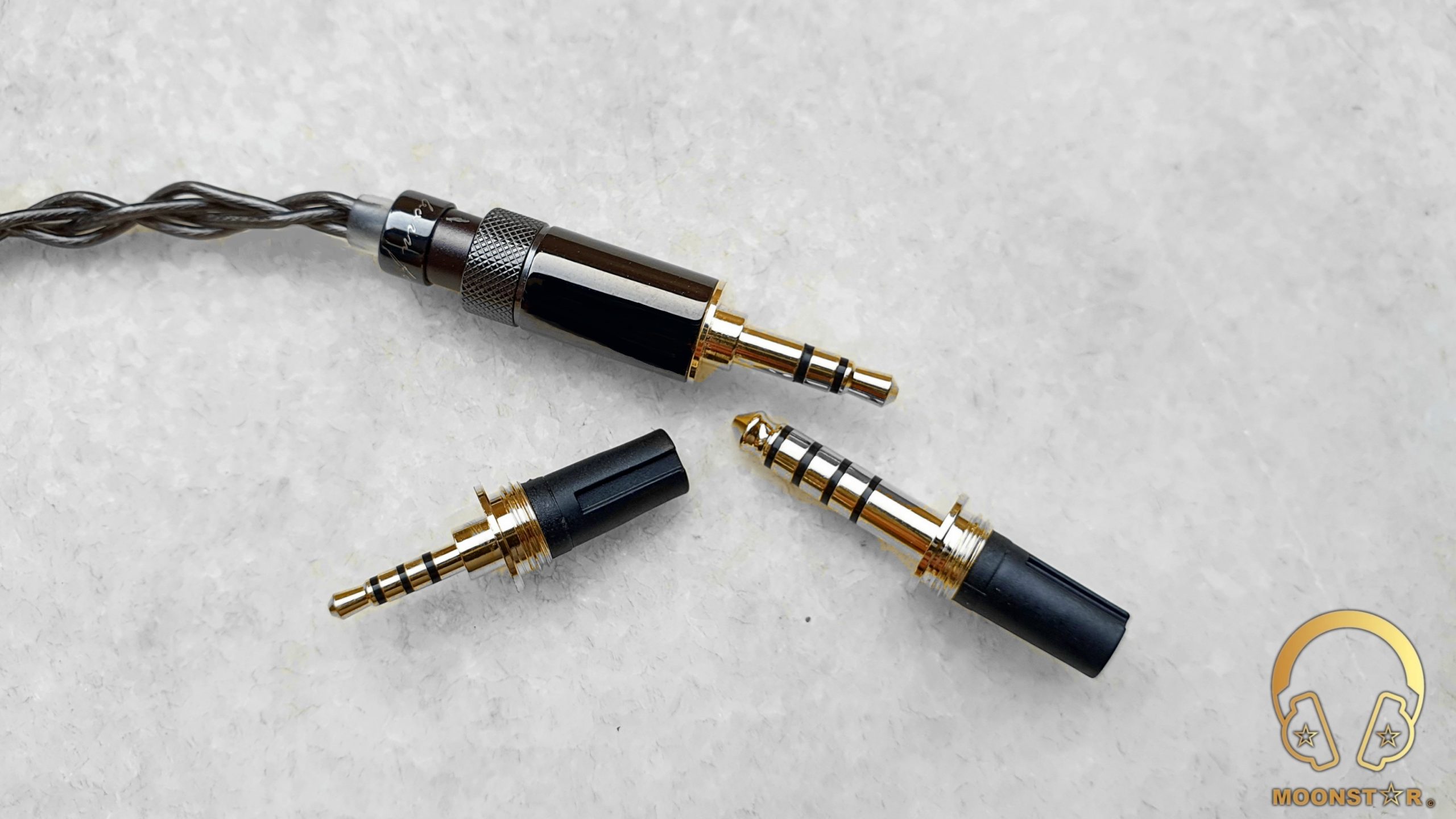
The housing of the headphone plug has a strait profile and is made of the same metal material in black color.
Isolation & Comfort:
The passive noise isolation of the FiiO FD7 is on an average level, since it features a unique semi-open-back design. However, the isolation is efficient enough for the use it in fairly noise environments such like a metro, bus or train.
The FiiO FD7 offers a quite ergonomic fit thanks to its curved cylindrical shape. This shape makes it pretty ideal for the use for longer listening periods without to hurt my ears with an average sized ear concha.
Drivability & Pairing:
The FiiO FD7 has an impedance of 50Ω (Ohm) and a sensitivity of about 111dB @ 1mW. It can be driven with relative weak sources such like Smartphone’s or Tablets. However, I do highly recommend to pair the FD7 with more powerful and detailed devices such like DAP’s (FiiO M11 Pro / M11 Plus) DAC/AMP’s (FiiO Q5s, BTR5), or DAC/Amplifier Dongles (FiiO KA3) to hear the true potential of this wonderful sounding In-Ear Monitor.

Remarkable Features:
A) 12mm Diameter Pure Beryllium Diaphragm [Edit]:
The FiiO FD7 utilizes a 12mm diameter pure beryllium diaphragm dynamic driver. Beryllium material is 4 times more rigid than steel while only weighing ¼ as much as titanium and has 3 times the transient performance compared to titanium drivers for a faster overall sound response.
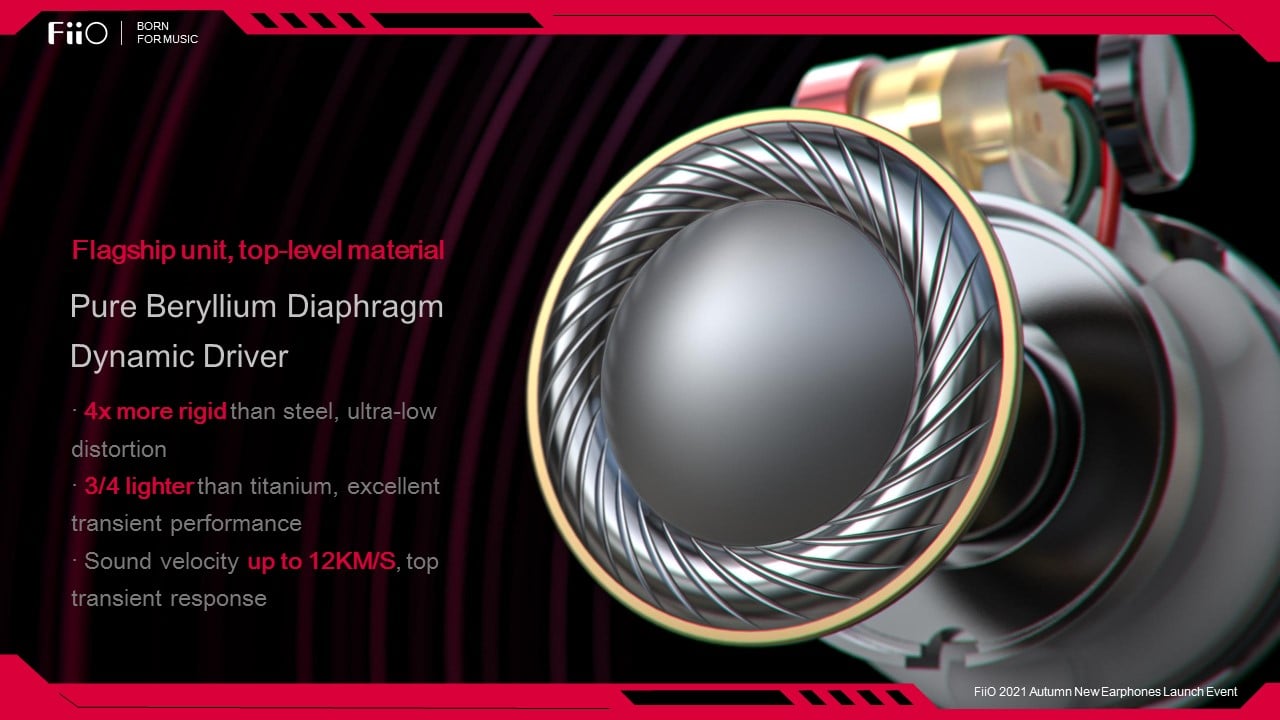
B) Volcanic Field & Semi-Open Design:
The “Volcanic Field” reduces standing waves and distortion, and overall improves the diffusion of bass waves in the FD7 wired earphones. In addition, the FD7’s semi-open design relieves pressure on the ear for more comfortable listening.
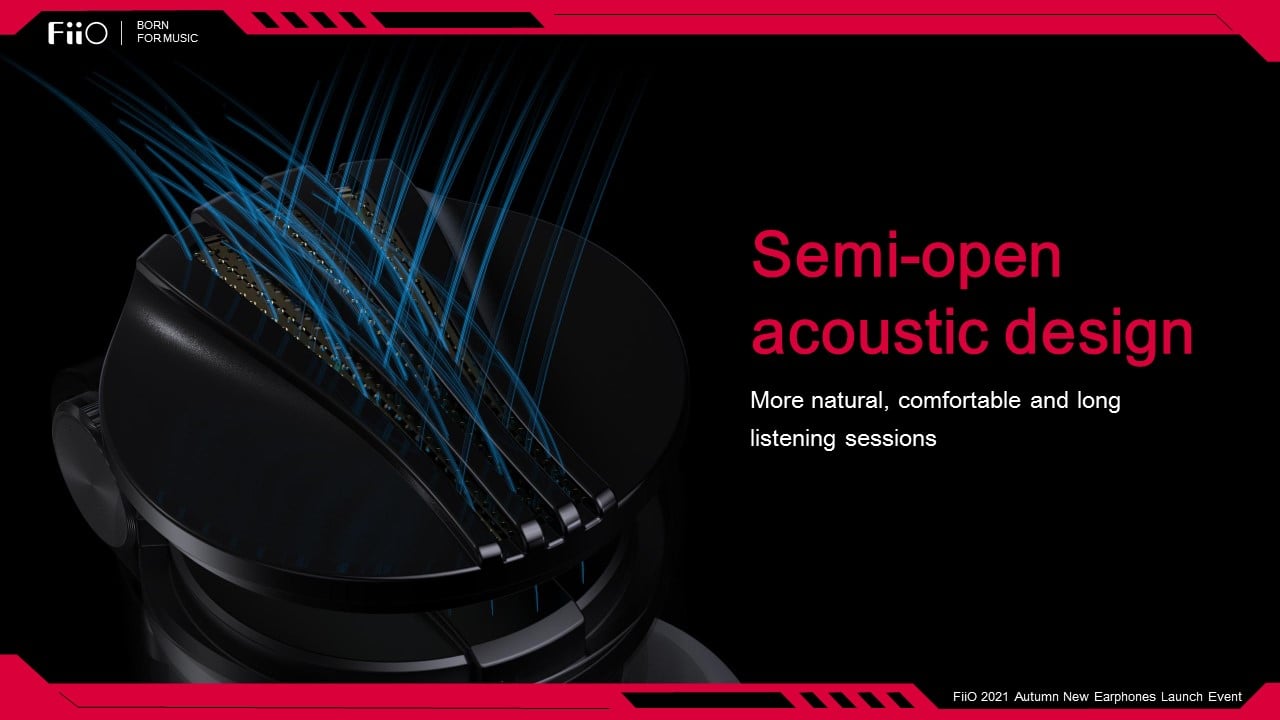
C) Acoustic Prism:
The FD7 features an acoustic prism system that effectively changes and precisely controls the way sound waves travel through the monitors to enhance how high frequency waves propagate and to ensure audio phases are correct.
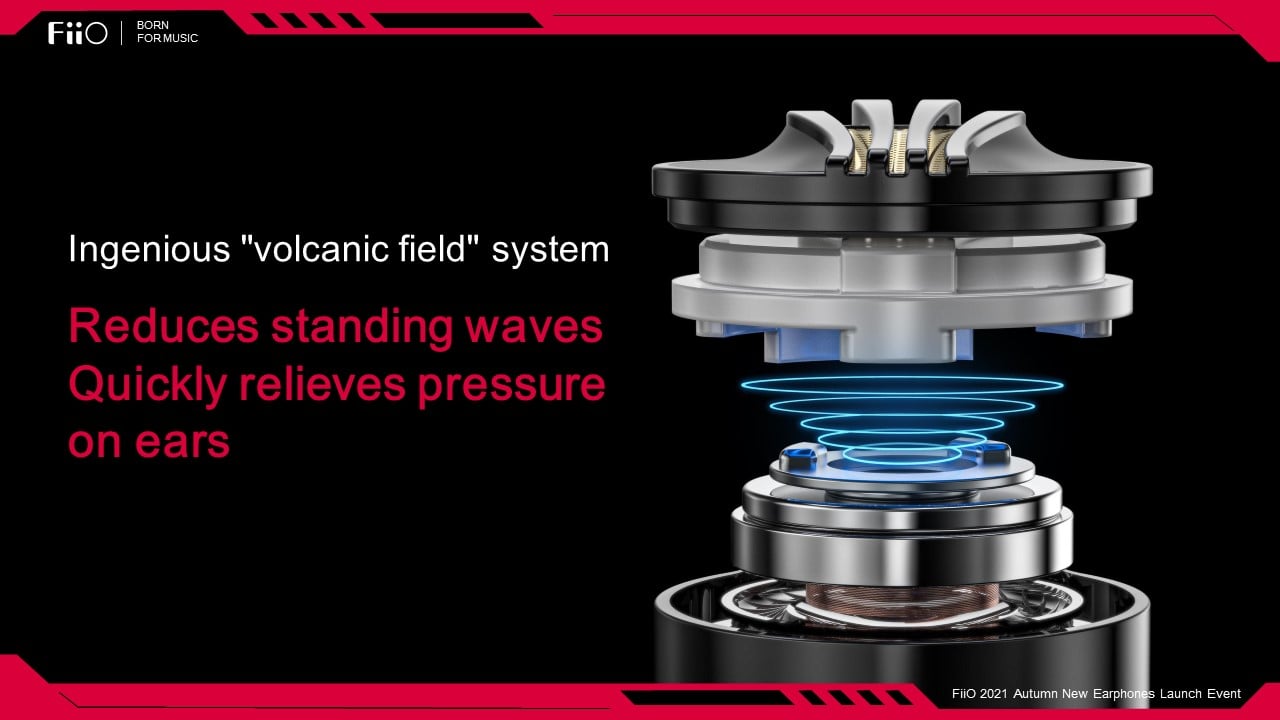
Technical Specifications:
- Driver Type : 12mm Pure Beryllium Diaphragm Dynamic Driver
- Frequency response : 10Hz-40kHz
- Impedance : 50Ω@1kHz
- Sensitivity : 111dB@1mW
- Max input power : 100mW
- Cable : 4 Core High Purity Monocrystalline Silver Wire Cable
- Cable length : 120cm
- Weight : 11 grams (single unit)
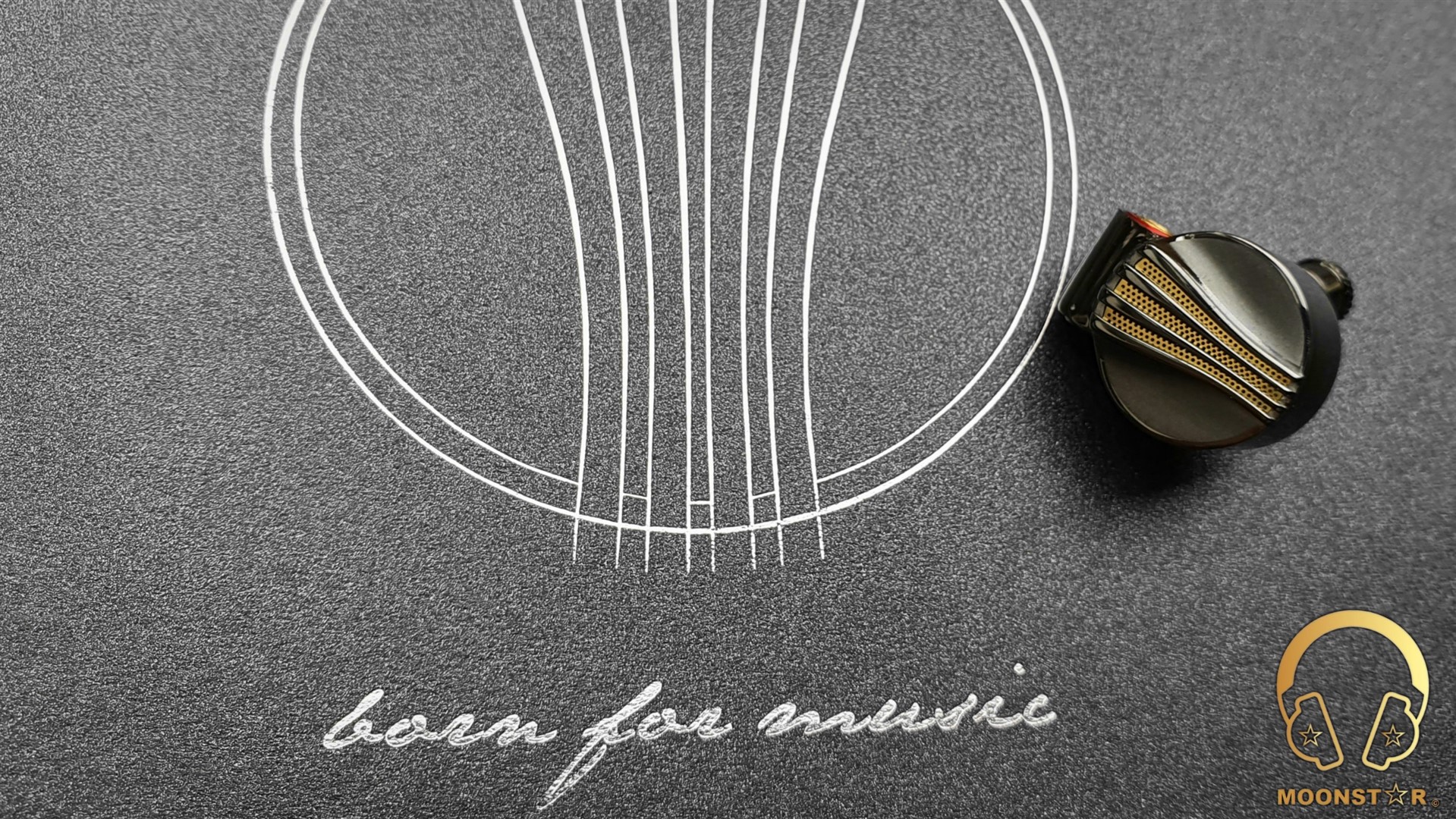
Sources used for this review:
- IEM : FiiO FD7, Final Audio B1, Metalure Wave
- DAP/DAC/AMP : FiiO M11 Pro, FiiO Q5s, FiiO BTR5, FiiO KA3
Albums & tracks used for this review:
- Adele – My Little Love (Spotify)
- Randy Crawford – On Day I Will Fly Away (Flac 16bit/44.1kHz)
- Mariah Carrey – Without You (Flac 16bit/44.1kHz)
- Hayley Westenra – Odyssey Album (Dezzer HiFi)
- Sarah McLachlan – Angel (Flac 24bit/48kHz)
- Sertap Erener – Aşk (Flac 16bit/44.1kHz)
- Edith Piaf – Non Je Ne Regrette Rien (Flac 16bit/44.1kHz)
- Diana Krall – So Wonderful (DSF)
- Aretha Franklin – I Say A Little Payer (Flac 24bit/96kHz)
- David Bowie – Heroes (Flac 24bit/192kHz)
- Elton John – Rocket Man ((Flac 24bit/96kHz)
- Barry White – Just The Way You Are (Flac 24bit/48kHz)
- Isaac Hayes – Walk On By (Flac 16bit/44.1kHz)
- Sting – Englishman in New York – (Flac 24bit/48kHz)
- Eric Clapton – Wonderful Tonight (Flac 24bit/96kHz)
- B.B. King – Riding With The King (Tidal Hi-Fi)
- Dave Gahan – Kingdom (Tidal Hi-Fi)
- U2 – Sunday Bloody Sunday (Flac 16bit/44.1kHz)
- Bro Safari, UFO! – Drama (Deezer HiFi)
- Armin Van Buuren – Vini Vici (Flac 16bit/44.1kHz)
- Really Slow Motion – Deadwood (Deezer HiFi)
- Jo Blankenburg – Meraki (Spotify)
- Lorde – Royal (Flac 24bit/48kHz)
- Toutant – Rebirth (Deezer HiFi)
- Gogo Penguin – Raven (Flac 24bit/192kHz)
- GoGo Penguin – Fanfares (Flac 24bit/192kHz)
- Portishead – It Could Be Sweet (Spotify)
- Charly Antolini – Duwadjuwandadu (Flac 24bit/192kHz)
- Michael Jackson – Billie Jean (Flac 24bit/192kHz)
- Ferit Odman – Look, Stop & Listen (Flac 24bit/192kHz)
- Chopin – Nocturn No. 20 In C-Sharp Minor (Flac 16bit/44.1kHz)
- Fazıl Say – Nazım Oratoryosu (Live) (Flac 16bit/44.1kHz)
- Vivaldi – Le QuarttroStagioni “The Four Season” (Deezer HiFi)
- Otto Liebert& Luna Negra – The River (Flac 24bit/192kHz)
- Lunatic Soul – The Passage (Flac 16bit/44.1kHz)
- Deftones – My Own Summer (Shove it) (Flac 16bit/44.1kHz)
- Photek – The Hiden Camera (Spotify)
- Muse – Hysteria (Flac 24bit/48kHz)
- Metallica – Sad but True (Flac 24bit/96kHz)
- Opeth – Windowpane (Flac 16bit/44.1kHz)
- Megadeth – Sweating Bullets (Tidal Hi-Fi)
- Rush – YYZ (Flac 16bit/44.1kHz)
- Rush – Leave That Thing Alone (Flac 16bit/44.1kHz)
- Slayer – Angel of Death (Spotify)s
- Liquid Tension Experiment 2 – Acid Rain (Spotify)
- Yosi Horikawa – Bubbles (Spotify)
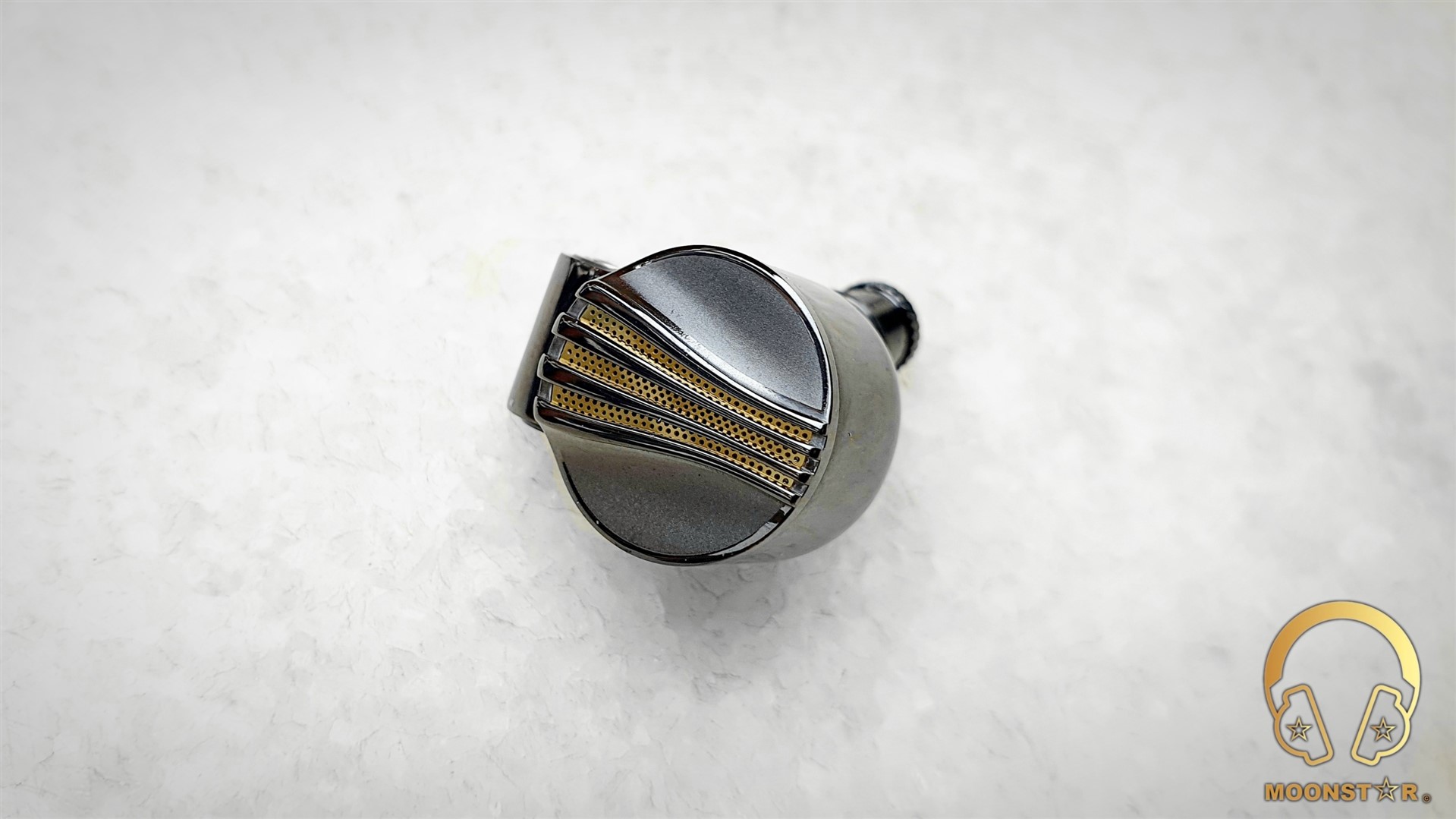
The Sound:
The FiiO FD7 is a very fluid, highly controlled and detailed sounding In-Ear Monitor, which shows a slightly warmer than neutral tonality and a pretty natural timbre that satisfied me immediately. The FD7 has a quite expansive and airy soundstage atmosphere that reminds me more to those of headphones rather than regular In-Ear Monitors. The bass shows a decent level of layering an impressive sense of speed and control. The midrange is highly transparent, organic and detailed, while the treble area is quite energetic but surprisingly controlled, and has a good grade of extension.

The FD7 comes with FiiO’s latest Interchangeable Sound Tube design. The package includes three (3) pairs of filters, which are the Bass, Balanced and Treble Tubes. The Balanced Tube offers the default tuning of the FD7, which is my favorite pair since it offers the most realistic, balanced and natural/uncolored presentation of this system.
Right below are my impressions and comparison of the Bass & Treble Tube, directly compared to the Balanced Sound Tuning Tube (Default/Reference).
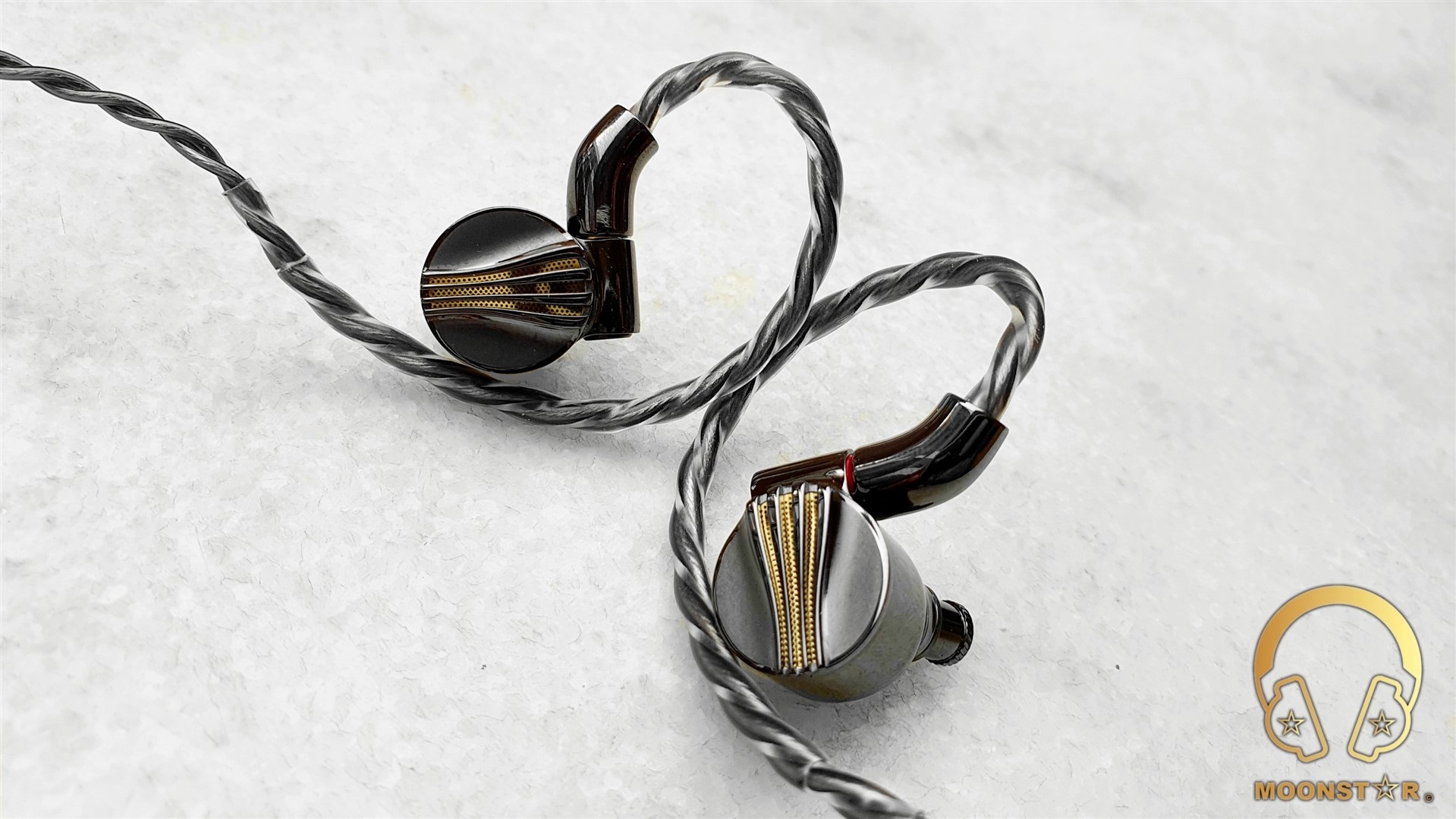
Bass Tube:
The Bass Tube is the one with the smallest diameter. It shows the warmest tonality and helps to increase the lower frequency response. It has the highest amount of coloration and shows the most entertaining sound signature of all tree Sound Tubes. The subbass region shows more depth and rumble, while the decay remains unchanged, which impressively fast for a dynamic driver IEM, thanks to the use of the Pure Beryllium Diaphragm. The midbass sounds slightly ore impactful compared to the Balanced and Treble filter, while the sense of speed and control in this are still unchanged. Moreover, the lower midrange shows more intensity compared to the balanced and treble filter, especially when I do listen to male vocals or strings like cellos and acoustic guitars.
Treble Tube:
The Treble Tube is the one with the brightest tonality. It is not a night and day difference but the still audible. The upper midrange and lower treble region sounds more highlighted compared to the Balanced Tube, especially the in direct comparison to the Bass Tube. The upper midrange shows a tad more transparency, while the lower midrange is losing some body and depth. The transitions from the upper midrange towards the treble region do still sound controlled. The lower treble region offers a bit more clarity, while the upper treble are gains some additional airiness and sparkle.

PS: This review has been written after a burn-in period of 160 hours since the Pure Beryllium Diaphragm needs some time to show its true potential. My impressions below are based to my impression with the Balanced Sound Tube that has been carefully installed to the FD7, which offers in my opinion the most realistic, versatile and pleasant to listen to sound profile. I have used the stock cable and the Balanced Silicone Ear Tips. My main sources are the FiiO M11 Pro and the FiiO Q5S. The list of tracks I have listen during this review are listed above for your information.
Analyzing the Frequency Response of the FiiO FD7:
Bass:
The FD7 utilizes a 12mm Pure Beryllium Diaphragm Dynamic Driver offers an impressive grade of bass speed and control. It is not as impactful like previous FD Series In-Ear Monitors such like the FD5, however the resolution, clarity and layering is on a TOTL level.
The subbass region of the FD7 has a moderate level of depth and extension, while the rumble is suitable for most genres especially when you use it with the Bass Tube. Bass heavy genres such like EDM, House music, Glitch hop, etc. are not the strength of the FD7, so if you prefer an IEM with thunderous subbass rumble instead of control and technicality in this area, the FD7 wouldn’t be the best choice.
The FiiO FD7 offers an outstanding performance in terms of authority when I do listen to songs with complex bass passages such like Gogo Penguin’s “Raven” and Photek’s “The Hidden Camera”.
The midbass region is a bit more pronounced compared to the subbass area. The tonality of this region is slightly warmer then neutral, while it shows an impressive sense of control, tightness and realism tanks to highly capable 12mm Pure Beryllium Diaphragm Dynamic Driver. Instruments from contrabass to drums, from def to bongo’s all have been reproduced in a pretty natural and realistic manner. The quality and intensity of the midbass is neither too low nor too much when you use the Bass Tube.

Midrange:
The FiiO FD7 shows a fluid, petty organic and natural midrange character and offers a nicely smooth and quite lively presentation in this area that got immediately my attention, especially when I have listen genres like jazz, blues and classical music. This area shows slightly warm tonality and a coloration that is there but not overdone. The midrange atmosphere is pretty transparent and airy, while the level of resolution is quite close to much more expensive Top Tier In-Ear Monitors.
Vocals & Instruments:
The general vocal presentation of the FiiO FD7 sounds quite realistic and detailed with both male and female. There is a slightly coloration in this area that helps to create a fluid and special timbre, which is quite exciting to listen to. The lower midrange has just the right amount of depth and body to create a pretty intimate and emotional male vocal presentation when I do listen to voices like Isaac Hayes, Sting or Barry White.
Female vocals do sound more detailed and lifelike compared to previous FiiO IEM’s including the FD5 and FH7. The tonality is a tad warmer than neutral, while the sense of clarity and resolution is top notch. What the FD7 makes so special in this area is that it is able to produce a decent level of vividness/brightness without to sound unnatural, to have negative conditions such as sibilance or sharpness, when I do listen to female voices like Edith Piaf, Sertap Erener or Mariah Carey.
The midrange of the FiiO FD7 shows an excellent sense of transparency and airiness, so that instruments are well separated from each other, which is an advantage when I do listen to songs with complex and instrument dense passages such like GoGo Penguin’s “Fanfares”. Instruments from pianos to cymbals, from flutes to cellos are reproduced in a pretty detailed and energetic yet nicely controlled manner, thanks to the well adjusted upper midrange that is produced by the Pure Beryllium Diaphragm Dynamic Driver.

Upper midrange & Treble:
The FiiO FD7 has offers a pretty rich and technically competitive upper midrange and treble performance for an In-Ear Monitor at this price category. It is more forgiving to poor recorded songs compared to the FD5, since it has a precise adjusted yet not overdone roll-off around the 3 kHz region that gives it a nice sense of smoothness in this area.
The upper midrange transitions are quite clear and highly controlled when I do listen to instruments such as cymbals, drums or to guitars. For example, the guitar solos played with high distortions such like those in Megadeth’s “Sweating Bullets”, Slayer’s “Angel of Deaths” and Rush’s “Leave That Thing Alone” are reproduced with a good level of authority and clarity.
The treble range of the FD7 sounds noticeably more controlled compared to the FD5, which sounded a bit sharp and also less forgiving to poor recorded songs. It still able to produce an excellent sense of clarity and resolution in the lower treble region, and is also able to create a decent grade of airiness and sparkle in the upper treble register.
Instruments such like cymbals or hi-hats in both jazz and metal music do sound nicely pronounced, detailed and are shown with a good level of extension. The FD7 is able to produce a decent sense of resolution and sparkle in this area, when I do listen to a wide variety of instruments from pianos to flutes, from violins to synthesizers.
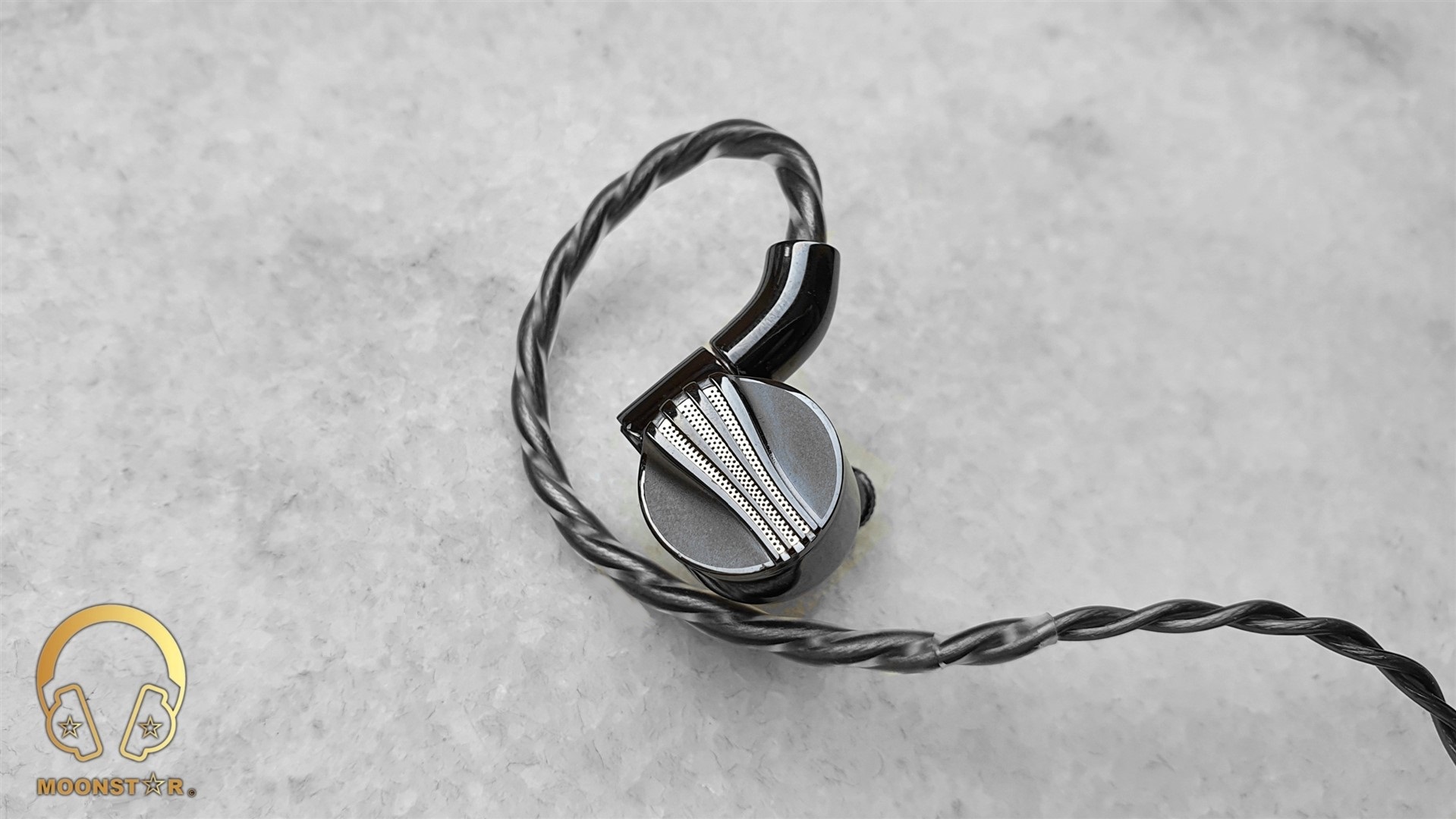
Soundstage & Imaging:
The FiiO FD7 shows a pretty realistic soundstage atmosphere with a decent sense of airiness and transparency thanks to the semi-open back design, which creates ideal conditions for a precise placement of instruments and vocals. The soundstage shows an above average wideness and pretty good level of depth and height.
Some Comparisons:
FiiO FD7 versus Final Audio B1:
The Final Audio B1 has a warmer tonality and shows a higher level of coloration compared to the FiiO FD7 that offers a more natural tonality and organic timbre.
The subbass region of the FD7 shows a slightly better level of depth and is superior in terms of authority and decay. The midbass area of the Final Audio B1 is more highlighted, warm, dens and impactful, however it can’t hold up with the FiiO FD7 when it comes to the clarity, resolution and overall layering in this area.
The midrange of the Final Audio B1 shows a warmer tonality and is also a bit more laid back in tits presentation, when compared to the FiiO FD7 that shows a more transparency and airiness in this area. The lower midrange of the B1 sounds pore pronounced and full-bodied, while the FD7 has the upper hand in terms of clarity and resolution. The upper midrange of the FiiO FD7 is more highlighted and detailed, while both IEMs do sound pretty controlled.
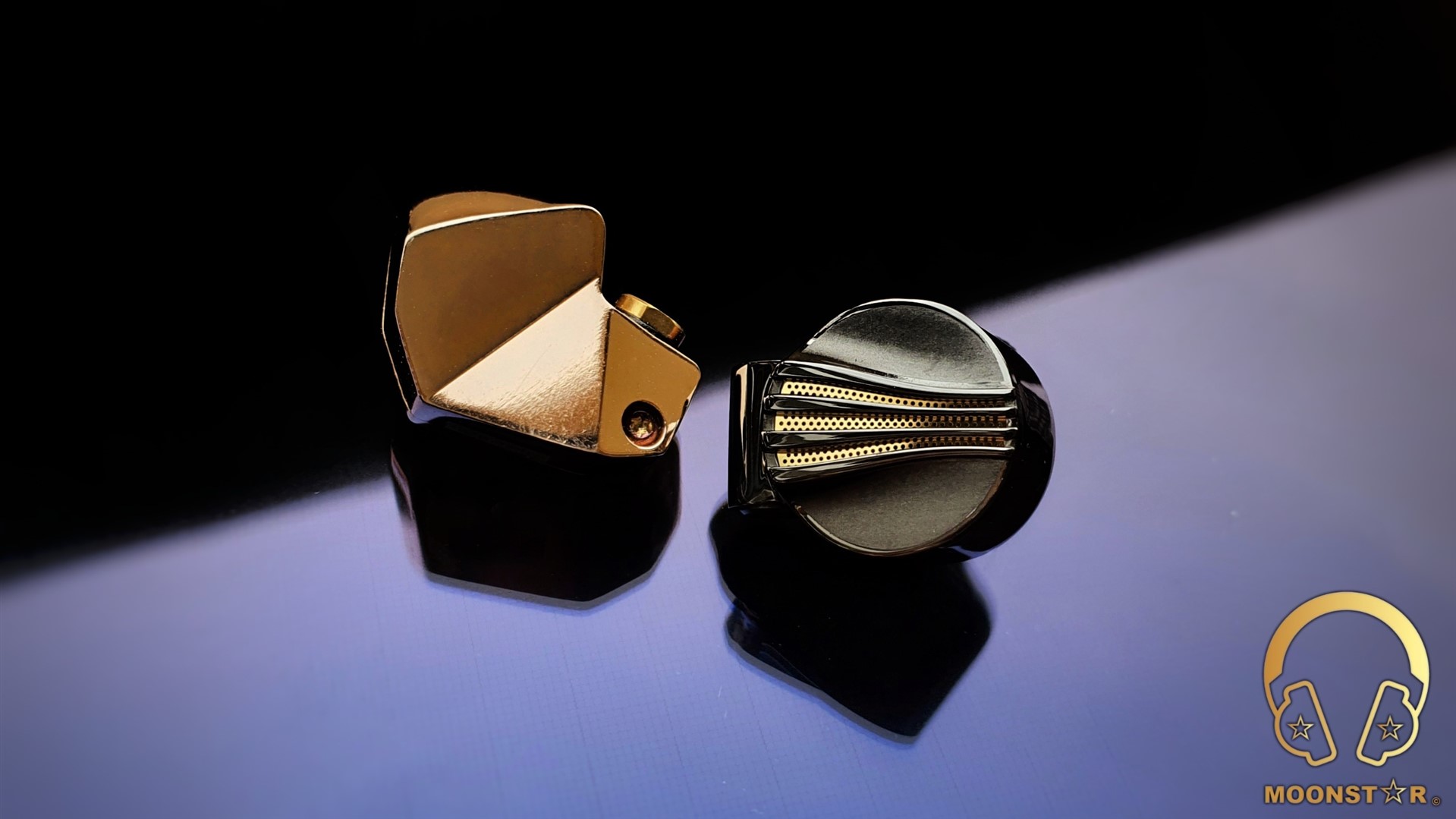
Both In-Ear Monitors are successful in the treble region in terms of technical performance.
The FiiO FD7 shows a more balanced, natural and controlled treble tuning, and offers also a better sense of clarity and definition in the lower treble region, while the Final Audio B1 has the slightly edge when it comes to the upper treble extension.
Both IEM’s are successful in terms of soundstage performance. However, the FiiO FD7 offers in general a better sense of airiness and spaces between instruments as well as vocals. The FD7 has the upper when it comes to the wideness of the stage, while the difference for the depth is quite minimal.
FiiO FD7 versus Metalure Wave:
The Metalure Wave is a pretty musical sounding In-Ear Monitor with a relative warm tonality that shows a mildly V shaped sound signature. The Wave is the IEM with a higher grade of coloration and shows a noticeably warmer tonality in direct comparison to the FD7.
Metalure Wave is slightly more successful in terms of subbass depth and quantity and shows more midbass intensity. The FiiO FD7 on the other hand is superior when it comes to the speed, control and layering in lower frequency region. The FD7 offers also better grade of clarity and has the slightly edge when it comes to the overall resolution.

The midrange of the Metalure Wave is warm and soft, while the level of transparency and airiness are on an average level. FiiO FD7 on the other hand, shows a more balanced, natural and transparent midrange presentation. The Wave has the upper hand in terms of lower midrange depth and male vocals, while the FD7 is superior when it comes to the general clarity and resolution of the midrange, especially in the upper midrange register.
The treble range of the FiiO FD7 offers a better sense of extension, clarity and definition while both IEM’s are controlled in this area. The upper treble region of the Metalure Wave sounds less airy and energetic compared to the FiiO FD7.
When it comes to the soundstage performance, I can say that the FiiO FD7 has the upper hand in terms of both wideness and depth.

Conclusion:
I am a lucky audiophile that has had the opportunity to review almost any FiiO IEM. Every new product of this company surprised me with its high value for its price, when it comes to the sound, esthetics and build quality. However, the FD7 is FiiO’s most natural, realistic and mature sounding IEM. It offers a very fluid, quite organic and detailed overall presentation from the lows up to the highs. This sound is packed in to a pretty comfortable and very esthetic looking monitor shell that comes with FiiO’s new interchangeable sound tube design, and a high purity silver cable with interchangeable plugs, which are part of the very rich accessory package.
Thank you for the Read!
Last edited:
Ichos
Reviewer at hxosplus
Pros: - Balanced, musical and engaging
- Very natural and organic timbre
- Excellent bass with thunderous dynamics
- Wide open and holographic soundstage with top imaging
- Smooth and transparent treble
- Comfortable fit
- Pure silver modular cable of high quality
- Comprehensive accessory pack
- Aggressively priced
- Very natural and organic timbre
- Excellent bass with thunderous dynamics
- Wide open and holographic soundstage with top imaging
- Smooth and transparent treble
- Comfortable fit
- Pure silver modular cable of high quality
- Comprehensive accessory pack
- Aggressively priced
Cons: - Sub - bass lacking in extension
- Needs absolutely high quality partnering sources
- Long "burning" time as suggested by the manufacturer
- Average passive noise attenuation
- Fit is not very stable
- The bass tuning nozzle lacks in control
- Needs absolutely high quality partnering sources
- Long "burning" time as suggested by the manufacturer
- Average passive noise attenuation
- Fit is not very stable
- The bass tuning nozzle lacks in control
The FiiO FD7 was kindly provided free of charge and I only covered import taxes and fees.
FiiO never asked for a favorable review and this is my honest and subjective evaluation.
The links are not affiliated and I don't get commission by clicking on them.
The FD7 selling price is €599.99 and you can buy it from FiiO.eu
Introduction
There is an on going frenzy about single Dynamic Driver iems, it seems to be the vogue now and FiiO is already into the game.
They have inaugurated their FD line with the FD5 (review), followed by the entry level FD3/FD3 Pro (review) and now they have released the flagship FD7 together with a special collectors edition called FDX.

Technical highlights
FiiO FD7 is equipped with a large 12mm dynamic driver unit that utilizes a pure Beryllium (and not beryllium coated) diaphragm coil.
Pure Beryllium Diaphragm offers splendid performance with swift mobility and sturdiness.
The new flagship 12mm pure beryllium diaphragm dynamic driver, due to beryllium being 4 times more rigid than steel while only weighing 14 as much as titanium, has 3 times the transient performance compared to titanium drivers for lightning-like speed and thunderous explosive sound.
Close to the pure beryllium driver in the FD7 is an acoustic prism system that addresses issues that come with the time delay between different sound waves.
It effectively changes and precisely controls the way sound waves travel through the FD7 to enhance how high frequency waves propagate and to ensure audio phases are correct.
The ingenious "volcanic field" system developed by FiiO takes advantage of how sound waves work to noticeably improve its sound.
The "volcanic field" reduces standing waves and distortion, and overall improves the diffusion of bass waves in the FD7.
In addition, the FD7's semi-open design relieves pressure on the ear for more comfortable listening.

Interchangeable sound tubes
Befitting of its flagship status, the FD7 comes standard with three pairs of interchangeable sound tubes, each with a different inner diameter for different sounds.
The large inner tube presents a vast soundstage, the medium inner tube impresses with its balanced sound, while the smallest inner tube serves up explosive bass.
Build quality and appearance
The FD7 shells are made from a solid block of stainless steel, carefully carved through a 5-axis CNC-milling process.
The build quality is top notch, the MMCX connectors look very sturdy and the finish is smooth without any visible spots.
In contrast to the glossy design of the FD5 the FD7 features a matte black "gunmetal" color with golden accents at the mesh.
They are very beautiful looking, reminding more of a jewel than an iem plus they offer a discrete fit.

Fit and isolation
The shape and dimensions are the same as with the other FD series iems, weighting 11gr per earpiece that is the same as the FD5 and a little heavier than the 7gr of the FD3.
Despite being rounded with that barrel-like design they actually fit very well and are comfortable, offering a stress free listening experience.
If there is a drawback is that you can't get a very steady fit so I wouldn't recommend them for exercise but anyway I don't see many people buying them for this use.
The bass enhancing tube is of narrower diameter so it may not offer the same kind of fit and some users would reach for the triple flange ear tips to get a better fit.
The semi-open design results in medium passive noise attenuation but it is not that bad as it sounds and increasing the volume a little will compensate for it but anyway you should get the most of the FD7 in a quiet environment.

Cable
The FD7 comes standard with a high-purity monocrystalline pure silver cable in Litz braided style.
Four large strands in a total of 224 wires are braided together in one cable.
The wire sheath is made of environmentally friendly medical grade TPU to resist yellowing after long-term use and against stiffening when in low-temperature environments.
And it comes with twist-lock interchangeable audio plugs for the 2.5/3.5/4.4mm sizes for ultimate convenience.
The twist-lock system is the most sturdy and future-proof design so I prefer it over twist or snap to fit.
The cable of the FD7 was designed with angled expanded MMCX connectors which went through many ergonomic iterations and improvements in order to achieve maximum wearing comfort.
The cable is absent from microphonic noise and offers excellent handling experience, it is a very high quality cable worthy of a flagship iem and some aftermarket cables of this quality cost more than the FD7 itself.
Accessories
Accessory pack is premium and with the FD7 you get the LC-RE(+) cable with 3.5mm, 2.5mm, and 4.4mm termination plugs, the new HB5 high quality storage case, three sound tubes screwed in a metallic card, an MMCX extraction tool, 6 bass eartips, 6 balanced eartips, 6 vocal eartips, 6 Spinfits, 2 triple-flange tips, and 4 foam tips all organized in a foam holder, a cleaning brush
and a magnetic cable organizer.

Listening set-up, power requirements
The FD7 is rated at 50Ω with a sensitivity of 111dB so while it is more difficult to drive than the common iems it isn't much of a challenge and all medium powered devices should be enough as long as they can provide some extra headroom.
Quality of course is another matter and make no mistake the FD7 is very demanding of it because it scales incredibly well and it is very transparent so you are going to need a high quality source in order to fully exploit its potential.
Give it something mediocre and it will sound as such, then switch to something great and you will be impressed with the results.
In other words you are going to need at least something mid tier like the EarMen Sparrow and the THX Onyx and then work your way up to higher tier like the FiiO M11 Plus and iBasso DX300 or even better something like the Cayin C9 which I was fortunate enough to have it on a loan and I was blown away with the performance.

Burning time
A few notes about the burning process, be a believer or not the company suggests that the FD7 pure beryllium driver needs at least 150 - 200 hours in order to break in and sound as intended.
Don't jump into rushed conclusions and please follow the instructions before you reach your final verdict.
Sound impressions
As per my usual practice, I avoid browsing into frequency response graphs since they tend to be deceiving and negatively affect my subconscious so I prefer the old school reviewing method of intensive music listening.
While waiting for the FD7 driver to break in I couldn't help myself reading various FD7 performance impressions to discover the hype that was building around it so I decided to forego my usual test tracks for a hardcore and stronger first challenge.
Nothing more stretching than Mahler's second symphony in this interpretation by Daniele Gatti.

The first opening bars were enough to establish a deep and strong impression about the FD7 personality and pave the way for what it was going to follow in the next few weeks.
The symphony starts with an ominous tremolo on the violins followed by cellos and low C double basses marching arpeggios that pose a great challenge regarding the low end performance.
In tune, full bodied, with weighty notes and exemplary layering, sharp attacks into the strings, well defined bowing, all these combined with top notch clarity which helped the following contrabassoon single-note statement to be clearly heard instead of being mashed by the double basses.
Then they enter solo cor anglais with oboes in a duet singing a mourning melody supported by blazing and glowing muted brass, leading after a short episode of violin lyricism into the first climax where we can hear the cymbal decaying with perfect timing and weight.
Throughout the whole symphony all instruments sounded with the most natural and convincing timbre that I could imagine, very close to reality not only in respect to the tuning but also for the textural quality.
The symphony's intensive harmonic complexity was clearly reproduced with exemplary coherency throughout the whole frequency range.
I was able to follow the multi-layered instrumentation and enjoy the myriads of tone colors that flooded my head, pouring out from dozens of different instruments from the bigger timpani, to the singing flutes, the pastoral bells and the well articulated voices that entered in the last two movements.
All instruments sounded clear and defined while the FD7 was resolving and detailed enough as not to miss a single note.
The masking effect was totally absent and every single instrument was clearly heard even while soloing pianissimo notes in the background of a large orchestra.
An orchestra, one of the largest available but the FD7, was able to stress the scene into a three dimensional plan with holographic projection and pinpoint accuracy, not only between individual instruments but also clearly defining the various instrumental groups.
Dimensionality aside, we also need to stretch our vision into time and the FD7 proved able to do so by communicating the sense of inner space and reverb of the recording venue, capturing the past and applying it into the present.
Another favorite piece that I use for checking dynamics is the percussion concerto "Siedi" by Kalevi Aho.

The concerto opens with a dialogue between solo djembe and the grand bass drum.
And the FD7 was able to capture all the thunderous dynamics of the bass drum hits and not only the control of the crushing strikes but also the reverb of the concert hall, while at the same time maintaining excellent clarity and speed to correctly present the lighting fast and well defined finger tapping of the djembe soloist.
The examples can continue for ever and make this review quite long but I can't help not mentioning a couple of more.
The Carmen Fantasy by Pablo de Sarasate was a good test to check the decay of the high pitched percussion instruments with the introductory tambourine hits that sounded brilliant, shimmering, full bodied and not too rushed.
Then after some chords on the harps enters the solo violin that was reproduced with plenty of harmonic wealth and a clear rendering of the various bowing techniques that are used throughout the piece.

The next example is a vocal quartet "Voglio Tempo" by G.F Handel for soprano, mezzo - soprano, alto, tenor and orchestra, a good track for checking vocal integrity and timbral saturation of the mid range.

The orchestra was widely arranged and the singers were precisely positioned from the left to the right with plenty of space between them.
All four were tonaly presented with the same gravitas and I was able to hear and enjoy the specific tone color of each singer.
The da capo section starts with the high soprano improvised cadenza reaching the limits of her vocal register, a stress exercise that can easily expose sibilance, harshness and ringing but the FD7 was absent of them and reproduced the full tessitura of the voice without sounding dull or muted.
One final example is the second scherzo in B flat minor by Chopin, a very challenging piano piece not only for the performer but also for the transducer.

The FD7 proved one more time to be excellent sounding as it reproduced the rich harmonic palette of the grand piano, the intense hammering of the strings, the fast arpeggios, the sudden dynamic changes, the pedaling effect, the furious scale runs, the attack and decay plus the timbral complexity of the instrument.
So to sum everything up, the FD7 offers a flagship level performance that concentrates around coherency, realistic timbre, natural tonality and texture quality without giving up too much in technicalities.
The overall tuning is close to the objective ideal by the means that all acoustic instruments must sound close to reality.
This is a subjective hobby and we all have our welcomed preferences but there must be an undeniably established objectivity about how transducers should be able to reproduce voices and unamplified instruments as close to the truth as it is possible.
This is the reference point from where we must start and then deviate according to our tastes and the FD7 sits very close to this ideal.
As you have noticed the review concentrates around classical music and this is done on purpose to highlight the musicality and organic nature of the FD7 but rest assured that it can easily cope and satisfy with all kinds of music as long as you don't like a mannered and manipulated sound approach, in such case you should look for something else.

A few notes about the sound tubes
The three sound tubes share the same overall sound signature with some differences here and there to tailor the sound to your needs.
I have decided for the reference tube with the balanced ear tips but the other two also yielded interesting results, sacrificing something in favor of something else.
The larger nozzle adds just a little bit of treble emphasis and sparkle at top giving the impression of a more open and detailed sound but slightly losing on timbral quality and texture.
The narrower tube doesn't enhance the bass but rather greatly rolls off the treble to give the impression of a boosted low end.
The takeaway is that it robs the highs of their energy, becoming more dull and also negatively affects the quality properties of the bass that becomes a little boomy and less controlled.
Further combinations can be done together with the various ear tips to micromanage the sound in order to better suit specific sound preferences and music genres.

Compared with the Sennheiser IE900
Disclaimer - The IE900 was returned before I started the FD7 evaluation but since I used it for more than two months continuously I feel confident to do a brief comparison.
The IE900 (review) is tuned with a gentle emphasis on the low end that adds real sub - bass extension, that is lacking from the FD7, and at the same time slightly boosts the lower bass above the reference point.
As such it can sound more lush and full bodied - compared to the leaner FD7 - and it will offer more satisfying experience with electronic bass, greatly pleasing the fans of the genre but at the expense of acoustic low bass instruments that will sound quite off tone and slightly mask the higher pitched members of the family like the cello.
The IE900 is amazing and top notch when it comes to quality characteristics and technical performance of the bass but the FD7 holds on its own without lacking either while there is a certain point where it takes the lead.
The FD7 larger driver can move great amounts of air and despite all the high - tech tricks that are employed inside the IE900, I am afraid that it comes second when we examine dynamic contrast and thrust with the FD7 giving more thunderous and slamming bass effects that fill not only the ears but the whole head of the listener.
Another key difference in tonality is that the IE900 has a more V-shaped tuning with recessed upper mids, as a result it sounds more distanced and not so engaging as the FD7 which in contrast feels more liquid and saturated in this region.
There is some brilliance emphasis that is used to add clarity, treble sparkle, enhanced detail retrieval and compensate for the extra bass boost tuning of the IE900.
The tuning is very ingeniously executed by the IE900 designers, so it manages to sound considerably more detailed, finer and resolving than the FD7 - without becoming analytical - but the penalty is that it slightly loses in timbre, gaining a metallic hue, becoming thin and with rushed decay while it is prone in becoming hot with certain material when the FD7 remains always smooth and controlled.
Both earphones share the same musical approach and excellent timbral qualities but in my opinion the FD7 has a small lead as it sounds more cohesive and natural from top to bottom.

Lastly there is a key difference between the two regarding the overall sound projection so when we compare them, the IE900 gives the impression of a reduced scale, the listener is like seated in the gallery watching to the spectacle from a distance and above while with the FD7 is positioned about third row in front of the orchestra and the experience feels certainly grander and larger in scale with more natural proportions.
At the end
The FiiO FD7 is an audiophile's dream; musical, engaging with superior timbral and textural qualities yet transparent and technically accomplished, it offers a holistic listening experience very close to reality.
If you have associated a flagship iem with extreme technicalities, hyper detail retrieval or some kind of specific tuning then the FD7 is not meant for you.
All others rest assured that the FD7 is worthy of an end game, flagship status and that comes at a very modest asking price.
Music listening is about sentiments, the continuous two way communication between the recorded performance and the listener with the headphone as the intermediate and the FD7 is a master of the trade.
Test playlist
Copyright - Laskis Petros 2021
FiiO never asked for a favorable review and this is my honest and subjective evaluation.
The links are not affiliated and I don't get commission by clicking on them.
The FD7 selling price is €599.99 and you can buy it from FiiO.eu
Introduction
There is an on going frenzy about single Dynamic Driver iems, it seems to be the vogue now and FiiO is already into the game.
They have inaugurated their FD line with the FD5 (review), followed by the entry level FD3/FD3 Pro (review) and now they have released the flagship FD7 together with a special collectors edition called FDX.

Technical highlights
FiiO FD7 is equipped with a large 12mm dynamic driver unit that utilizes a pure Beryllium (and not beryllium coated) diaphragm coil.
Pure Beryllium Diaphragm offers splendid performance with swift mobility and sturdiness.
The new flagship 12mm pure beryllium diaphragm dynamic driver, due to beryllium being 4 times more rigid than steel while only weighing 14 as much as titanium, has 3 times the transient performance compared to titanium drivers for lightning-like speed and thunderous explosive sound.
Close to the pure beryllium driver in the FD7 is an acoustic prism system that addresses issues that come with the time delay between different sound waves.
It effectively changes and precisely controls the way sound waves travel through the FD7 to enhance how high frequency waves propagate and to ensure audio phases are correct.
The ingenious "volcanic field" system developed by FiiO takes advantage of how sound waves work to noticeably improve its sound.
The "volcanic field" reduces standing waves and distortion, and overall improves the diffusion of bass waves in the FD7.
In addition, the FD7's semi-open design relieves pressure on the ear for more comfortable listening.

Interchangeable sound tubes
Befitting of its flagship status, the FD7 comes standard with three pairs of interchangeable sound tubes, each with a different inner diameter for different sounds.
The large inner tube presents a vast soundstage, the medium inner tube impresses with its balanced sound, while the smallest inner tube serves up explosive bass.
Build quality and appearance
The FD7 shells are made from a solid block of stainless steel, carefully carved through a 5-axis CNC-milling process.
The build quality is top notch, the MMCX connectors look very sturdy and the finish is smooth without any visible spots.
In contrast to the glossy design of the FD5 the FD7 features a matte black "gunmetal" color with golden accents at the mesh.
They are very beautiful looking, reminding more of a jewel than an iem plus they offer a discrete fit.

Fit and isolation
The shape and dimensions are the same as with the other FD series iems, weighting 11gr per earpiece that is the same as the FD5 and a little heavier than the 7gr of the FD3.
Despite being rounded with that barrel-like design they actually fit very well and are comfortable, offering a stress free listening experience.
If there is a drawback is that you can't get a very steady fit so I wouldn't recommend them for exercise but anyway I don't see many people buying them for this use.
The bass enhancing tube is of narrower diameter so it may not offer the same kind of fit and some users would reach for the triple flange ear tips to get a better fit.
The semi-open design results in medium passive noise attenuation but it is not that bad as it sounds and increasing the volume a little will compensate for it but anyway you should get the most of the FD7 in a quiet environment.

Cable
The FD7 comes standard with a high-purity monocrystalline pure silver cable in Litz braided style.
Four large strands in a total of 224 wires are braided together in one cable.
The wire sheath is made of environmentally friendly medical grade TPU to resist yellowing after long-term use and against stiffening when in low-temperature environments.
And it comes with twist-lock interchangeable audio plugs for the 2.5/3.5/4.4mm sizes for ultimate convenience.
The twist-lock system is the most sturdy and future-proof design so I prefer it over twist or snap to fit.
The cable of the FD7 was designed with angled expanded MMCX connectors which went through many ergonomic iterations and improvements in order to achieve maximum wearing comfort.
The cable is absent from microphonic noise and offers excellent handling experience, it is a very high quality cable worthy of a flagship iem and some aftermarket cables of this quality cost more than the FD7 itself.
Accessories
Accessory pack is premium and with the FD7 you get the LC-RE(+) cable with 3.5mm, 2.5mm, and 4.4mm termination plugs, the new HB5 high quality storage case, three sound tubes screwed in a metallic card, an MMCX extraction tool, 6 bass eartips, 6 balanced eartips, 6 vocal eartips, 6 Spinfits, 2 triple-flange tips, and 4 foam tips all organized in a foam holder, a cleaning brush
and a magnetic cable organizer.

Listening set-up, power requirements
The FD7 is rated at 50Ω with a sensitivity of 111dB so while it is more difficult to drive than the common iems it isn't much of a challenge and all medium powered devices should be enough as long as they can provide some extra headroom.
Quality of course is another matter and make no mistake the FD7 is very demanding of it because it scales incredibly well and it is very transparent so you are going to need a high quality source in order to fully exploit its potential.
Give it something mediocre and it will sound as such, then switch to something great and you will be impressed with the results.
In other words you are going to need at least something mid tier like the EarMen Sparrow and the THX Onyx and then work your way up to higher tier like the FiiO M11 Plus and iBasso DX300 or even better something like the Cayin C9 which I was fortunate enough to have it on a loan and I was blown away with the performance.

Burning time
A few notes about the burning process, be a believer or not the company suggests that the FD7 pure beryllium driver needs at least 150 - 200 hours in order to break in and sound as intended.
Don't jump into rushed conclusions and please follow the instructions before you reach your final verdict.
Sound impressions
As per my usual practice, I avoid browsing into frequency response graphs since they tend to be deceiving and negatively affect my subconscious so I prefer the old school reviewing method of intensive music listening.
While waiting for the FD7 driver to break in I couldn't help myself reading various FD7 performance impressions to discover the hype that was building around it so I decided to forego my usual test tracks for a hardcore and stronger first challenge.
Nothing more stretching than Mahler's second symphony in this interpretation by Daniele Gatti.

The first opening bars were enough to establish a deep and strong impression about the FD7 personality and pave the way for what it was going to follow in the next few weeks.
The symphony starts with an ominous tremolo on the violins followed by cellos and low C double basses marching arpeggios that pose a great challenge regarding the low end performance.
In tune, full bodied, with weighty notes and exemplary layering, sharp attacks into the strings, well defined bowing, all these combined with top notch clarity which helped the following contrabassoon single-note statement to be clearly heard instead of being mashed by the double basses.
Then they enter solo cor anglais with oboes in a duet singing a mourning melody supported by blazing and glowing muted brass, leading after a short episode of violin lyricism into the first climax where we can hear the cymbal decaying with perfect timing and weight.
Throughout the whole symphony all instruments sounded with the most natural and convincing timbre that I could imagine, very close to reality not only in respect to the tuning but also for the textural quality.
The symphony's intensive harmonic complexity was clearly reproduced with exemplary coherency throughout the whole frequency range.
I was able to follow the multi-layered instrumentation and enjoy the myriads of tone colors that flooded my head, pouring out from dozens of different instruments from the bigger timpani, to the singing flutes, the pastoral bells and the well articulated voices that entered in the last two movements.
All instruments sounded clear and defined while the FD7 was resolving and detailed enough as not to miss a single note.
The masking effect was totally absent and every single instrument was clearly heard even while soloing pianissimo notes in the background of a large orchestra.
An orchestra, one of the largest available but the FD7, was able to stress the scene into a three dimensional plan with holographic projection and pinpoint accuracy, not only between individual instruments but also clearly defining the various instrumental groups.
Dimensionality aside, we also need to stretch our vision into time and the FD7 proved able to do so by communicating the sense of inner space and reverb of the recording venue, capturing the past and applying it into the present.
Another favorite piece that I use for checking dynamics is the percussion concerto "Siedi" by Kalevi Aho.

The concerto opens with a dialogue between solo djembe and the grand bass drum.
And the FD7 was able to capture all the thunderous dynamics of the bass drum hits and not only the control of the crushing strikes but also the reverb of the concert hall, while at the same time maintaining excellent clarity and speed to correctly present the lighting fast and well defined finger tapping of the djembe soloist.
The examples can continue for ever and make this review quite long but I can't help not mentioning a couple of more.
The Carmen Fantasy by Pablo de Sarasate was a good test to check the decay of the high pitched percussion instruments with the introductory tambourine hits that sounded brilliant, shimmering, full bodied and not too rushed.
Then after some chords on the harps enters the solo violin that was reproduced with plenty of harmonic wealth and a clear rendering of the various bowing techniques that are used throughout the piece.

The next example is a vocal quartet "Voglio Tempo" by G.F Handel for soprano, mezzo - soprano, alto, tenor and orchestra, a good track for checking vocal integrity and timbral saturation of the mid range.

The orchestra was widely arranged and the singers were precisely positioned from the left to the right with plenty of space between them.
All four were tonaly presented with the same gravitas and I was able to hear and enjoy the specific tone color of each singer.
The da capo section starts with the high soprano improvised cadenza reaching the limits of her vocal register, a stress exercise that can easily expose sibilance, harshness and ringing but the FD7 was absent of them and reproduced the full tessitura of the voice without sounding dull or muted.
One final example is the second scherzo in B flat minor by Chopin, a very challenging piano piece not only for the performer but also for the transducer.

The FD7 proved one more time to be excellent sounding as it reproduced the rich harmonic palette of the grand piano, the intense hammering of the strings, the fast arpeggios, the sudden dynamic changes, the pedaling effect, the furious scale runs, the attack and decay plus the timbral complexity of the instrument.
So to sum everything up, the FD7 offers a flagship level performance that concentrates around coherency, realistic timbre, natural tonality and texture quality without giving up too much in technicalities.
The overall tuning is close to the objective ideal by the means that all acoustic instruments must sound close to reality.
This is a subjective hobby and we all have our welcomed preferences but there must be an undeniably established objectivity about how transducers should be able to reproduce voices and unamplified instruments as close to the truth as it is possible.
This is the reference point from where we must start and then deviate according to our tastes and the FD7 sits very close to this ideal.
As you have noticed the review concentrates around classical music and this is done on purpose to highlight the musicality and organic nature of the FD7 but rest assured that it can easily cope and satisfy with all kinds of music as long as you don't like a mannered and manipulated sound approach, in such case you should look for something else.

A few notes about the sound tubes
The three sound tubes share the same overall sound signature with some differences here and there to tailor the sound to your needs.
I have decided for the reference tube with the balanced ear tips but the other two also yielded interesting results, sacrificing something in favor of something else.
The larger nozzle adds just a little bit of treble emphasis and sparkle at top giving the impression of a more open and detailed sound but slightly losing on timbral quality and texture.
The narrower tube doesn't enhance the bass but rather greatly rolls off the treble to give the impression of a boosted low end.
The takeaway is that it robs the highs of their energy, becoming more dull and also negatively affects the quality properties of the bass that becomes a little boomy and less controlled.
Further combinations can be done together with the various ear tips to micromanage the sound in order to better suit specific sound preferences and music genres.

Compared with the Sennheiser IE900
Disclaimer - The IE900 was returned before I started the FD7 evaluation but since I used it for more than two months continuously I feel confident to do a brief comparison.
The IE900 (review) is tuned with a gentle emphasis on the low end that adds real sub - bass extension, that is lacking from the FD7, and at the same time slightly boosts the lower bass above the reference point.
As such it can sound more lush and full bodied - compared to the leaner FD7 - and it will offer more satisfying experience with electronic bass, greatly pleasing the fans of the genre but at the expense of acoustic low bass instruments that will sound quite off tone and slightly mask the higher pitched members of the family like the cello.
The IE900 is amazing and top notch when it comes to quality characteristics and technical performance of the bass but the FD7 holds on its own without lacking either while there is a certain point where it takes the lead.
The FD7 larger driver can move great amounts of air and despite all the high - tech tricks that are employed inside the IE900, I am afraid that it comes second when we examine dynamic contrast and thrust with the FD7 giving more thunderous and slamming bass effects that fill not only the ears but the whole head of the listener.
Another key difference in tonality is that the IE900 has a more V-shaped tuning with recessed upper mids, as a result it sounds more distanced and not so engaging as the FD7 which in contrast feels more liquid and saturated in this region.
There is some brilliance emphasis that is used to add clarity, treble sparkle, enhanced detail retrieval and compensate for the extra bass boost tuning of the IE900.
The tuning is very ingeniously executed by the IE900 designers, so it manages to sound considerably more detailed, finer and resolving than the FD7 - without becoming analytical - but the penalty is that it slightly loses in timbre, gaining a metallic hue, becoming thin and with rushed decay while it is prone in becoming hot with certain material when the FD7 remains always smooth and controlled.
Both earphones share the same musical approach and excellent timbral qualities but in my opinion the FD7 has a small lead as it sounds more cohesive and natural from top to bottom.

Lastly there is a key difference between the two regarding the overall sound projection so when we compare them, the IE900 gives the impression of a reduced scale, the listener is like seated in the gallery watching to the spectacle from a distance and above while with the FD7 is positioned about third row in front of the orchestra and the experience feels certainly grander and larger in scale with more natural proportions.
At the end
The FiiO FD7 is an audiophile's dream; musical, engaging with superior timbral and textural qualities yet transparent and technically accomplished, it offers a holistic listening experience very close to reality.
If you have associated a flagship iem with extreme technicalities, hyper detail retrieval or some kind of specific tuning then the FD7 is not meant for you.
All others rest assured that the FD7 is worthy of an end game, flagship status and that comes at a very modest asking price.
Music listening is about sentiments, the continuous two way communication between the recorded performance and the listener with the headphone as the intermediate and the FD7 is a master of the trade.
Test playlist
Copyright - Laskis Petros 2021
Last edited:
Pros: Quick-response bass; thick mids; smooth treble; affordable price.
Cons: There is not as much bass as FD3; Not suitable for a soprano; A little heavy; needs more output power from the DAP.
Originally posted at FiiO’s FD series share the same driver? & FD7 brief review
Recently, I saw a rumor on the Internet that FD3 and FD5 are using the same drivers. I also have such doubts, so, keen to explore the truth, I borrowed an FD5 and an FD7 from the headset store to compare them together, and in order to distinguish FD3 from FD5 from the front, I also borrowed a black FD3Pro.

FiiO’s FD series iems remind me of another series of products from a famous brand: Sony’s EX series. FD3, FD5 and FD7 are just like EX600, EX800st and EX1000 ---their products of the same series have similar appearances, similar drivers, and similar sound tuning, but their pricing ranges are very different. Sony's EX1000 used to be the most distinctive iem I have ever heard.(Original Image on crinacle.com)

Back to FiiO’s FD series, when I borrowed them, the first thing I did was to remove the sound tube and check the drivers. I did not unexpectedly find that the three earphone drivers are indeed different. The diaphragm of FD3's dynamic drivers has the lowest transparency, and I can see the red coil; from the FD5, I can see the beryllium-coated dome diaphragm like a mirror. Its transparency is lower than that of the FD3 drivers, which may be related to the amount of beryllium-coated. And the structure is different, more differences I found on FiiO’s official website: the texture of FD5’s diaphragm and FD3’s are also different; and the FD7 diaphragm has the lowest-transparency diaphragm, which seems to be opaque. And the diaphragm surface, which does look like a piece of metal, does not have the same smoothness as the FD3’s and

Of course, the difference between their drivers is not convincing in terms of appearance alone. For me, I am not willing to look at the various words in the advertisement. Its sound determines whether I will choose it. So I tested them with non-professional equipment. I have used the same sound tube (black), the same ear tips, and the same cable (the original FD7 cable) to test them.

It can be seen that the sound between them is indeed different, and this difference is not obtained by low-level tuning techniques such as damping in the sound tubes. They do change the drivers. It is commendable that FiiO's earphone products have extremely high quality control, and the left and right ears match extremely well. Speaking of the sound, the actual experience of the differences between these three earphones is more impressive than the measurements below. When I switch to FD3 after listening to FD7, I can immediately feel that the bass of FD3 is not as tight as FD7, and the treble is brighter than FD7 (the fact is that I prefer the treble of FD3). Yes, the pure beryllium drivers brings a softer sound to the FD7.

So can fd7 become a thunderous product like ex1000? I would say my answer first, I think it can. The first earphone in my memory that uses pure beryllium diaphragm is the Final a8000, but it is a pity that its price has reached 1999 USD, which is unaffordable for an average worker like me who are not rich enough, so it is a pity , I was not lucky enough to try this earphone. But the price of FiiO FD7 is less than one-third of the price of final a8000, and at the launch event, the slogan of "Young People's First Truly Pure Beryllium Earphone" even appeared on the screen. Because I haven't listened to a8000, I can only guess the sound differences between it and FD7 based on the frequency response diagram: the overall sound style is similar, but the bass of FD7 may be less than A8000, the resolution of a8000 may not be as good as FD7 as the very high frequency part of a8000 is lower than FD7. Of course, it is just a guess. Similar frequency response diagrams may have different sense of hearing. But if I pay more than three times the price, but only get a small difference in sound, even a higher price may be exchanged for weaker resolution, which will be really surprising to me.(Original Image on crinacle.com)

During this time, another new product also attracted me, Dunu Zen Pro. It has a round shape appearance similar to the FiiO FD series, a pure metal diaphragm driver, also, similar to FD7. Dunu claims the Zen Pro to be the "most worth buying earphone within ten thousand yuan" (Although Dunu may have this confidence, I don’t think it’s a good idea to say so).

Compared with FD7, Zen Pro has a richer bass, provides a stronger sense of atmosphere, closer vocals, and is more suitable for popular songs. The sound of FD7 is more flat, because it has a softer bass, I will not feel the mids and treble overwhelmed by the bass. In short, the Zen Pro sound is warmer, and the FD7 is colder and flatter, and their sound quality is comparable and are all very good, however, the price of Zen Pro is too high (Zen Pro=FD7+discounted FD5), and it does not support replacing of the sound tube, even if I used to be a fan of Dunu (from Titan1 to DK3001), it also dispelled my desire to buy.
Recently, I saw a rumor on the Internet that FD3 and FD5 are using the same drivers. I also have such doubts, so, keen to explore the truth, I borrowed an FD5 and an FD7 from the headset store to compare them together, and in order to distinguish FD3 from FD5 from the front, I also borrowed a black FD3Pro.

FiiO’s FD series iems remind me of another series of products from a famous brand: Sony’s EX series. FD3, FD5 and FD7 are just like EX600, EX800st and EX1000 ---their products of the same series have similar appearances, similar drivers, and similar sound tuning, but their pricing ranges are very different. Sony's EX1000 used to be the most distinctive iem I have ever heard.(Original Image on crinacle.com)

Back to FiiO’s FD series, when I borrowed them, the first thing I did was to remove the sound tube and check the drivers. I did not unexpectedly find that the three earphone drivers are indeed different. The diaphragm of FD3's dynamic drivers has the lowest transparency, and I can see the red coil; from the FD5, I can see the beryllium-coated dome diaphragm like a mirror. Its transparency is lower than that of the FD3 drivers, which may be related to the amount of beryllium-coated. And the structure is different, more differences I found on FiiO’s official website: the texture of FD5’s diaphragm and FD3’s are also different; and the FD7 diaphragm has the lowest-transparency diaphragm, which seems to be opaque. And the diaphragm surface, which does look like a piece of metal, does not have the same smoothness as the FD3’s and

Of course, the difference between their drivers is not convincing in terms of appearance alone. For me, I am not willing to look at the various words in the advertisement. Its sound determines whether I will choose it. So I tested them with non-professional equipment. I have used the same sound tube (black), the same ear tips, and the same cable (the original FD7 cable) to test them.

It can be seen that the sound between them is indeed different, and this difference is not obtained by low-level tuning techniques such as damping in the sound tubes. They do change the drivers. It is commendable that FiiO's earphone products have extremely high quality control, and the left and right ears match extremely well. Speaking of the sound, the actual experience of the differences between these three earphones is more impressive than the measurements below. When I switch to FD3 after listening to FD7, I can immediately feel that the bass of FD3 is not as tight as FD7, and the treble is brighter than FD7 (the fact is that I prefer the treble of FD3). Yes, the pure beryllium drivers brings a softer sound to the FD7.

So can fd7 become a thunderous product like ex1000? I would say my answer first, I think it can. The first earphone in my memory that uses pure beryllium diaphragm is the Final a8000, but it is a pity that its price has reached 1999 USD, which is unaffordable for an average worker like me who are not rich enough, so it is a pity , I was not lucky enough to try this earphone. But the price of FiiO FD7 is less than one-third of the price of final a8000, and at the launch event, the slogan of "Young People's First Truly Pure Beryllium Earphone" even appeared on the screen. Because I haven't listened to a8000, I can only guess the sound differences between it and FD7 based on the frequency response diagram: the overall sound style is similar, but the bass of FD7 may be less than A8000, the resolution of a8000 may not be as good as FD7 as the very high frequency part of a8000 is lower than FD7. Of course, it is just a guess. Similar frequency response diagrams may have different sense of hearing. But if I pay more than three times the price, but only get a small difference in sound, even a higher price may be exchanged for weaker resolution, which will be really surprising to me.(Original Image on crinacle.com)

During this time, another new product also attracted me, Dunu Zen Pro. It has a round shape appearance similar to the FiiO FD series, a pure metal diaphragm driver, also, similar to FD7. Dunu claims the Zen Pro to be the "most worth buying earphone within ten thousand yuan" (Although Dunu may have this confidence, I don’t think it’s a good idea to say so).

Compared with FD7, Zen Pro has a richer bass, provides a stronger sense of atmosphere, closer vocals, and is more suitable for popular songs. The sound of FD7 is more flat, because it has a softer bass, I will not feel the mids and treble overwhelmed by the bass. In short, the Zen Pro sound is warmer, and the FD7 is colder and flatter, and their sound quality is comparable and are all very good, however, the price of Zen Pro is too high (Zen Pro=FD7+discounted FD5), and it does not support replacing of the sound tube, even if I used to be a fan of Dunu (from Titan1 to DK3001), it also dispelled my desire to buy.
Last edited:
Wasaabi
When listening to pop songs, the warm sound of ZenPro and more bass will make you feel like you are at live.
WAON303
Wondering if these make for a good mid-fi set.
I'll be getting a $300-600 IEM later in January. the FD7 looks tempting as ****. I'm a sucker for sleek IEM designs and I don't have any IEMs with pure bery DDs (The Closest I own is the DUNU EST 112 which has a bery coated DD.)
Bad Boy and Super Reviews have said that the FD7 is decent but is bottlenecked by the price (Indeed, given that $600 gives you access to the Oracle and Variations which are two of the best IEMs you can buy under a grand.)
I'll be getting a $300-600 IEM later in January. the FD7 looks tempting as ****. I'm a sucker for sleek IEM designs and I don't have any IEMs with pure bery DDs (The Closest I own is the DUNU EST 112 which has a bery coated DD.)
Bad Boy and Super Reviews have said that the FD7 is decent but is bottlenecked by the price (Indeed, given that $600 gives you access to the Oracle and Variations which are two of the best IEMs you can buy under a grand.)
Wasaabi
It is recommended to choose according to your taste. I also reviewed the Variations. For me, most of Moondrop's products lack mids, while FiiO's products have more dense mids.
If you care about the mids, the FD7 is good; if the treble, the Variations is good. The Oracle should have similar sound characteristics to the Variations, I haven't listened to it yet.
By the way, I recommend the FH9 more than FD7. It has recently received many good reviews in our country. I think it is FiiO's best iem so far.
If you care about the mids, the FD7 is good; if the treble, the Variations is good. The Oracle should have similar sound characteristics to the Variations, I haven't listened to it yet.
By the way, I recommend the FH9 more than FD7. It has recently received many good reviews in our country. I think it is FiiO's best iem so far.
Dsnuts
Headphoneus Supremus
Pros: High end solid all metal build with excellent flagship level packaging. Very nicely matched pure silver cable with modular connectors, 15 pairs of tips, a spacious box case, mmcx separator tool and 3 different nozzle tubes that gives you slight treble tweaks. Highly resolving pure Beryllium sound with arguably Fiios best balanced tuning to date. Easily comparable to other flagship Beryllium dynamic earphones. Expansive large wide stage, organic tonality with superb timbre. No treble spikes, deep rumbly Beryllium Bass. Takes to amping like a champ. Aggressively priced for the sound and pure Beryllium.
Cons: Absolutely requires a longer break in period. Reviews that you see about the FD7 with no burn in. Open box sound is not any better than their FD5. Average passive isolation due to being semi open. 50 ohm means you need to push the FD7 with your more powerful DAPs and Amps.
Fiio FD7

A few surprises have come from Fiio this year and none more surprising than their new FD7. Their dynamic series has arguably been some of the best earphones the group have made and it seems Fiio has been hard at work to bring the enthusiast their highest end dynamic earphones in the new FD7. I am starting to see a certain design and sound philosophy of what Fiio has been doing with their dynamic series of earphones. Fiios house sound always includes some semblance of balance utilizing a variation of the V shaped signature, always includes bass for their tunings and best of all they seem to always try to improve on what they have established from their past designs. That my friends, is a good sign that they care about sound.

The FD5 was the first to use this new inhouse designed alloy metal semi open housing design that Fiio has used for 3 different earphones. Their more recent FD3, FD5 and now the FD7. One of the benefits of using the same housing design is that it actually cuts costs down at the production level for Fiio which trickles down to the consumer when purchasing a set for you. An established housing allows the designers to focus on driver composition and the tuning associated with that driver. When news broke out that Fiio will be producing a 12mm pure Beryllium dynamic earphone in the new FD7. Ok now we are talking about a higher level of earphone.
Pure Beryllium means it will have to be their absolute top performing earphone. With the cost of new flagship earphones skyrocketing in recent years. Anything called a flagship can raise a brow just how expensive earphones can get nowadays. The FD7 sells for the RP of $599 when available some might say it is too expensive, I beg to differ. I say it is more than competitive, it is a down right bargain for what you're getting if we are comparing apples to apples for the design vs other real pure Beryllium Dynamic earphones.
As an owner of other pure Beryllium dynamic flagships I can honestly say what Fiio has achieved with the FD7 has more than exceeded my expectations of them and let me tell you why.

The FD7 was provided for the purpose of a review from Fiio you can read up on what the FD7 is about here. The FD7 will be on sale on Amazon here and on their web site on Aliexpress here. The FD7 was burned in for an approximate 200 hours and was scrutinized by yours truly using my IBasso DX300Max, Fiio M15, Shanling M6 pro, M5s, Fiio K3 2021, IFI Black Label and Ibasso PB3 for amping.
A word about burn in.
I know some folks don’t do it for whatever reason but if you plan on spending this type of money. You are absolutely required to burn these in for a minimum of 100 hours, a good 200 hours to be complete. Here is the reason why. These are using pure Beryllium dynamics. Yes, the same type of Beryllium others such as Dunu and Final use on their flagships. To me it is clear, if you plan on buying the FD7 and don't do burn in cus you're cool like that. I cannot recommend the FD7 for you. Because these will sound not so great out of the box. In fact truth be told, I felt the FD5 had a better sound in comparison. Of course that was out of the box. They sounded compressed, with a narrower stage and bright with not so good dynamics on open listen. This all changes with burn in. If you're the type that will have nothing to do with burn in. Skip this read and skip on the FD7 cus you're not going to hear from the FD7 as I am describing them on my review here. You're better off buying the FD3 and saving yourself $500.

Package and build
What you get with your hard earned cash is a much larger variety of tips than what most provide, 15 pairs to be exact, a mmcx disconnect tool, a worthy case to carry around your precious and best of all a 4 core monocrystalline pure silver cable with Fiios version of their modular plug connectors in all balanced formats and single ended. I have to admit we get spoiled a bit by Fiio with their packaging. What they provide here shows great care and attention to detail in their products. The tip variety alone is heads and shoulders above what you get with most IEMs. Something I can’t say is provided with a majority of IEM manufacturers. The shells are exactly the same dimensions and shape of their previous FD3 and FD5. A highly customized barrel design but is semi open at the back grills of the FD7. The housing is a solid all alloy metal housing strong yet not so heavy in the ears. The build should provide a lifetime of listening as long as you don’t treat the ear pieces with kid gloves.
A semi open design means it will let the Beryllium dynamic drivers here breathe which gives you a more open type sound adding to a larger stage in the process but the negative there is that these will not isolate like an all resin design or a closed design. Its passive isolation is only average here at best. I would say even a bit below average, but the trade off is the sound that I will be describing.

The mmcx modular cable that comes with the FD7 this time was clearly thought out as a design choice for the FD7. The cable enhances the technical aspects of the FD7. You can use a pure silver cable on an earphone that has balancing as a fundamental tuning design and this ends up enhancing that sound overall. This cable enhances the stage, details, imaging and tone of the new FD7 to sound its absolute best.. But….Only after burn in.
Folks that prefer their FD7 to have a slight warmth in tone should try an aftermarket higher end pure copper cable or a mix thereof to get both type of cable effects. For now just know the cables Fiio provides synergizes well with the FD7. A bit of a history on cable matchups. I have been the most staunch critic when it comes to cable matchups and this time around they matched up the cable perfectly fine. Props to Fiio for paying attention to this one very important aspect of the package and sound design.

How do they sound?
Overall tuning of the FD7 has their best balanced mildy v shaped tuning the group has provided for their dynamic earphones to date. It is not leaning toward neutrality or is the tuning overly colored but is somewhere in the middle which bodes well for actually listening to music. Supremely musical yet highly technical, it includes 3 different sized nozzles with varying effects on the treble emphasis to tweak the balancing a bit for you. Instead of using filter meshes on the tips of the nozzles the thickness or the diameter of the nozzles provides slight degrees of treble emphasis for the sound balancing and how you like your trebles.

This aspect is a bit like going from using a narrow earphone tip vs a wider open tip and how that opens up the trebles which affects the overall balancing and how you hear the trebles. The largest nozzle has the most open sound and the most treble emphasis but even with the largest nozzle the sound still has good fundamental balancing. Having an option to slightly tweak the treble end via nozzle changes is not an option on most earphones so this is a nice little advantage for the FD7.
The medium nozzle is the default nozzle and it provides the best balanced tuning and the narrow nozzle at around 3mm wide provides more focused sound for the bass end of the FD7 with slightly lesser treble emphasis over the larger nozzles. I found that you will have to resort to using some aftermarket tips for the narrow nozzle as the included triple flange tips are not ideal for the narrow nozzle for me anyways. I got great results using Final E tips and or Sony hybrids with the narrow nozzle.
The tuning of the FD7 does not have a larger treble spike in the trebles which allows for a much better even handed balancing for the mids and bass to play equal parts for the FD7 tuning. Not to mention it will be ideal for longer every day listening sessions.

Trebles
FD7 trebles have the most emphasis at the lower treble region. Treble emphasis is very much linear toward the mid bands and does not seem to stick out with the use of some type of overexaggerated treble spike. It has the safest treble tuning out of the recent Fiio earphone offerings and sees a gradual treble de emphasis toward upper trebles. No question the FD7 has good treble extension reaching an astounding 40Khz on graph provided by Fiio and on the opposite end the bass reaching to 10 hz. It will be a matter of just how much treble you prefer but the largest nozzle does provide a slight uptick in treble emphasis, providing the absolute widest stage possible. This review was mostly done using their default balanced nozzle.
A safe treble tuning even with the use of their widest nozzle means it has enough emphasis to sound complete but does not stand on its own. In doing such a tuning means the FD7 is resolving and refined enough but at the same time will not fatigue you with a bright treble emphasis. Treble transients and details are very good showing plenty of micro accents to complete and refine a treble end. Again treble extension and emphasis is ideal here and the fact that each nozzle has a varying degree of how you like your trebles means much like their previous FD series of earphones. The FD7 treble emphasis is tunable. The truly resolving aspect of the FD7 means with every change in the sound chain of the FD7, be it a new cable or source, it is advisable to re-explore tips and the different nozzles to dial down the FD7 sound to your liking.

The treble this time some might argue, might be somewhat subdued in emphasis for upper trebles. It is not the airiest of trebles I have heard but very middle ground as far as air, presence and detail. The treble plays a fine line of being resolving and detailed enough but just lacking that last bit of shimmer due to the upper treble slope. I am more nit picking here more than anything the pure Beryllium dynamic being used for the FD7 is clearly capable for all the sound ranges and it shows just how resolving it is in the treble region. In my opinion the trebles of the FD7 are easily the best tuned and refined out of all their previous dynamics.
Treble tuning has a mild roll off which results in the trebles to be non fatiguing yet detailed which is what you want to hear albums in their entirety. The crisp, clean detailed trebles of the FD7 are presented to enhance your music and not to be the star of the show. This is a refreshing change for Fiio from their previous FH5s and FD5 treble tunings. Fiio is letting the natural ability of their Beryllium dynamic handle that treble response. This in turn makes for a satisfying, easier even keeled listening for the trebles of the FD7 yet very satisfactory at the same time.

Mids
Mids of the FD7 is where the FD7 is every bit as good as anything I have heard at the flagship level. There is no mistaking the resolving ability of pure Beryllium for the FD7. The mids expand and take over your senses. Mids for the FD7 has a modest pinna gain so nothing that artificially enhances the mid range to have an unnatural tonal character or anything that is unduly bright. The FD7s after burn in start to sound organic and rich with details that you would expect from a highly resolving monitor. I remember there were some rumblings of how the FD5s lower mid range was not full enough for some. No issues with the FD7 this time. Again it all comes down to that balancing aspect of the tuning. Mids final sound is superb in detail and timbrally accurate. It is the type of mids you can get lost in. Music sounds rich, dense, organic, precise and fantastically dimensional all the same time.

Macro detailing for the mids are superb. Micro detailing comes easy. This is where I feel burn in has really opened up the sound. Mids cover a large spacious stage on the FD7 and you know you're dealing with some of the best mids Fiio has thrown out on anything they have made. The FD7 presents with a full on rangy vocal performance and instruments with a timbre that will leave you wanting to hear more. Its richness makes everything sound so awesomely realized that you keep on wanting to listen till the wee hours at night. Mids have superior imaging for dynamics, and have an organic smoothness with a precision that lesser dynamics just can’t touch. It gets you into your music with a very musical yet clearly technical sound performance which is the ultimate sign that you're dealing with something special. This is most definitely not your garden variety dynamic earphone in sound. Busy tracks are not a thing for the FD7 as the sound has such good resolve and control. Everything you throw at the FD7, its tight sound will portray how it was meant to be.
The mids are the heart of your music and if you don’t get timbre, tone and space right for the mids you might as well quit. FD7 is clearly playing on a different level for the mids. It is exactly how you would expect a highly resolving Beryllium dynamic should sound for the mids and it delivers on all fronts. Your music will sound more nuanced, more cohesive and more dynamic all with one of the best spacious presentations you can hear for an earphone. Win win and more win here.

Bass
Bass end of the FD7 is moderate in impact and emphasis but make no mistake this is a pure Beryllium bass. Even dynamics that are just coated in Beryllium does not struggle much if at all for the low end. The FD7s bass is sheer control with a tightness you would expect from a highly magnetized pure Beryllium driver. That detailed nature of pure Beryllium for bass means bass is tight, speedy, punchy and supremely detailed when called for. When it comes to sub bass it will rumble with an ideal texture you can only get from pure Beryllium. Fiio didn’t go overboard on the bass aspect for the FD7 as that would ruin the lovely mids they produce. No off bass tonality, no flabbiness, no bloaty mess and certainly no weak limp neutral bass either. It isn’t the end all authority on bass but the bass is not taking a 2nd or even 3rd place in the sound tuning. As detailed as the treble and mids are, the bass end has equal definition.
The low end rumble will impress bass guys with just how good the bass responds to the low notes. Bass is supremely gifted and talented. Bass digs deep and I can believe it reaches 10hz. I threw on the bass switches from the IFI Black label and yes we are talking basshead levels now and it takes the bass enhancement like a champ. The one of many aspects I love about the FD7 is just how controlled the entire sound is. You want control for your speedy bass, You want that bass punch to hit you just right, you want that deep hard hitting rumble when called for all done with high levels of bass detail. This makes the FD7 versatile for a huge variety of music and is most certainly not just a one trick pony. It is just as great for something like Orchestral scores to 90s hip hop to modern pop, jazz, metal, EDM to folk music.

Technicalities
There is no mistaking the quality of the FD7 and the sheer resolving nature of pure Beryllium. Stage has a natural expansion. I say natural because there is no treble spike and a recessed lower mids here to make it seem like you're hearing a larger stage. Nope this time around the large wider well imaged stage is due to that pure Beryllium sound. If you're wondering if the cheaper earphone you're listening to that claims it is using a Beryllium dynamic. If it has a narrow in your head stage. Guess what, It is probably not. There is a certain spacial, ambient quality to pure Beryllium I noticed that is unmistakable.
The FD7 reproduces the ambient spacious nature of the recorded track and never have I heard a true Beryllium dynamic earphone have a confined stage. The FD7 stage is so well proportioned with good height and an ideal depth, sometimes awe inspiring width for earphones. It helps with that outstanding imaging and a dense fullness that the FD7 has. Sound separation is yet another aspect that pure Beryllium shows. It has a superior background black space that coated dynamics don’t seem to do as well. Its detail retrieval is ideal and best of all some of the best timbres I have heard for natural instruments on just about any earphone.
So what do you get when you have superior transient response, superior dynamics, superior imaging, superior timbre, superior sound stage, superior deep rumbly bass and a superior richer organic tone? You get Fiios best sounding earphones to date. This is the reason why I can argue the price tag is actually a great value here. You don’t have to worry about coherency issues, wonky treble spikes, too much upper mids, too little lower mids, an over bloated bass, weak technicalities or too narrow a stage. None of that applies to the FD7.

In the end.
You want and expect a highly refined product from a trusted manufacturer. That is what the FD7 is all about. The quality, the workmanship, the value and most of all the sound. The FD7 delivers in such a huge way. It is gonna be difficult for them to top this one, as a huge fan of dynamic earphones, Fiio has just thrown down their best effort to date and the good news there is that it doesn't cost 3X the price to get this sound. It's got all parts of the sound firing off on all cylinders with a technical aspect that is clearly flagship level.
You own a small cashe of IEMs but have you ever heard a true pure Beryllium dynamic earphone? These are more than worthy of your consideration, I see these being the most affordable true Beryllium dynamic in the market today with no sacrifices for the sound. That, my friends, is substantial. These aren’t just competing with other earphones at the price, they are competing with some of the best the industry has to offer… But.. only if you burn them in.
Thanks for taking the time to read. Go get yourself a FD7 and be happy you got a true Beryllium dynamic earphone. One last message for you. Due to the 50 ohm impedance they do need some juice to really show you what they are all about. Your more powerful sources, DAPs and amps apply here. Good stuff in= amazing Beryllium sound out.

A few surprises have come from Fiio this year and none more surprising than their new FD7. Their dynamic series has arguably been some of the best earphones the group have made and it seems Fiio has been hard at work to bring the enthusiast their highest end dynamic earphones in the new FD7. I am starting to see a certain design and sound philosophy of what Fiio has been doing with their dynamic series of earphones. Fiios house sound always includes some semblance of balance utilizing a variation of the V shaped signature, always includes bass for their tunings and best of all they seem to always try to improve on what they have established from their past designs. That my friends, is a good sign that they care about sound.

The FD5 was the first to use this new inhouse designed alloy metal semi open housing design that Fiio has used for 3 different earphones. Their more recent FD3, FD5 and now the FD7. One of the benefits of using the same housing design is that it actually cuts costs down at the production level for Fiio which trickles down to the consumer when purchasing a set for you. An established housing allows the designers to focus on driver composition and the tuning associated with that driver. When news broke out that Fiio will be producing a 12mm pure Beryllium dynamic earphone in the new FD7. Ok now we are talking about a higher level of earphone.
Pure Beryllium means it will have to be their absolute top performing earphone. With the cost of new flagship earphones skyrocketing in recent years. Anything called a flagship can raise a brow just how expensive earphones can get nowadays. The FD7 sells for the RP of $599 when available some might say it is too expensive, I beg to differ. I say it is more than competitive, it is a down right bargain for what you're getting if we are comparing apples to apples for the design vs other real pure Beryllium Dynamic earphones.
As an owner of other pure Beryllium dynamic flagships I can honestly say what Fiio has achieved with the FD7 has more than exceeded my expectations of them and let me tell you why.

The FD7 was provided for the purpose of a review from Fiio you can read up on what the FD7 is about here. The FD7 will be on sale on Amazon here and on their web site on Aliexpress here. The FD7 was burned in for an approximate 200 hours and was scrutinized by yours truly using my IBasso DX300Max, Fiio M15, Shanling M6 pro, M5s, Fiio K3 2021, IFI Black Label and Ibasso PB3 for amping.
A word about burn in.
I know some folks don’t do it for whatever reason but if you plan on spending this type of money. You are absolutely required to burn these in for a minimum of 100 hours, a good 200 hours to be complete. Here is the reason why. These are using pure Beryllium dynamics. Yes, the same type of Beryllium others such as Dunu and Final use on their flagships. To me it is clear, if you plan on buying the FD7 and don't do burn in cus you're cool like that. I cannot recommend the FD7 for you. Because these will sound not so great out of the box. In fact truth be told, I felt the FD5 had a better sound in comparison. Of course that was out of the box. They sounded compressed, with a narrower stage and bright with not so good dynamics on open listen. This all changes with burn in. If you're the type that will have nothing to do with burn in. Skip this read and skip on the FD7 cus you're not going to hear from the FD7 as I am describing them on my review here. You're better off buying the FD3 and saving yourself $500.

Package and build
What you get with your hard earned cash is a much larger variety of tips than what most provide, 15 pairs to be exact, a mmcx disconnect tool, a worthy case to carry around your precious and best of all a 4 core monocrystalline pure silver cable with Fiios version of their modular plug connectors in all balanced formats and single ended. I have to admit we get spoiled a bit by Fiio with their packaging. What they provide here shows great care and attention to detail in their products. The tip variety alone is heads and shoulders above what you get with most IEMs. Something I can’t say is provided with a majority of IEM manufacturers. The shells are exactly the same dimensions and shape of their previous FD3 and FD5. A highly customized barrel design but is semi open at the back grills of the FD7. The housing is a solid all alloy metal housing strong yet not so heavy in the ears. The build should provide a lifetime of listening as long as you don’t treat the ear pieces with kid gloves.
A semi open design means it will let the Beryllium dynamic drivers here breathe which gives you a more open type sound adding to a larger stage in the process but the negative there is that these will not isolate like an all resin design or a closed design. Its passive isolation is only average here at best. I would say even a bit below average, but the trade off is the sound that I will be describing.

The mmcx modular cable that comes with the FD7 this time was clearly thought out as a design choice for the FD7. The cable enhances the technical aspects of the FD7. You can use a pure silver cable on an earphone that has balancing as a fundamental tuning design and this ends up enhancing that sound overall. This cable enhances the stage, details, imaging and tone of the new FD7 to sound its absolute best.. But….Only after burn in.
Folks that prefer their FD7 to have a slight warmth in tone should try an aftermarket higher end pure copper cable or a mix thereof to get both type of cable effects. For now just know the cables Fiio provides synergizes well with the FD7. A bit of a history on cable matchups. I have been the most staunch critic when it comes to cable matchups and this time around they matched up the cable perfectly fine. Props to Fiio for paying attention to this one very important aspect of the package and sound design.

How do they sound?
Overall tuning of the FD7 has their best balanced mildy v shaped tuning the group has provided for their dynamic earphones to date. It is not leaning toward neutrality or is the tuning overly colored but is somewhere in the middle which bodes well for actually listening to music. Supremely musical yet highly technical, it includes 3 different sized nozzles with varying effects on the treble emphasis to tweak the balancing a bit for you. Instead of using filter meshes on the tips of the nozzles the thickness or the diameter of the nozzles provides slight degrees of treble emphasis for the sound balancing and how you like your trebles.

This aspect is a bit like going from using a narrow earphone tip vs a wider open tip and how that opens up the trebles which affects the overall balancing and how you hear the trebles. The largest nozzle has the most open sound and the most treble emphasis but even with the largest nozzle the sound still has good fundamental balancing. Having an option to slightly tweak the treble end via nozzle changes is not an option on most earphones so this is a nice little advantage for the FD7.
The medium nozzle is the default nozzle and it provides the best balanced tuning and the narrow nozzle at around 3mm wide provides more focused sound for the bass end of the FD7 with slightly lesser treble emphasis over the larger nozzles. I found that you will have to resort to using some aftermarket tips for the narrow nozzle as the included triple flange tips are not ideal for the narrow nozzle for me anyways. I got great results using Final E tips and or Sony hybrids with the narrow nozzle.
The tuning of the FD7 does not have a larger treble spike in the trebles which allows for a much better even handed balancing for the mids and bass to play equal parts for the FD7 tuning. Not to mention it will be ideal for longer every day listening sessions.

Trebles
FD7 trebles have the most emphasis at the lower treble region. Treble emphasis is very much linear toward the mid bands and does not seem to stick out with the use of some type of overexaggerated treble spike. It has the safest treble tuning out of the recent Fiio earphone offerings and sees a gradual treble de emphasis toward upper trebles. No question the FD7 has good treble extension reaching an astounding 40Khz on graph provided by Fiio and on the opposite end the bass reaching to 10 hz. It will be a matter of just how much treble you prefer but the largest nozzle does provide a slight uptick in treble emphasis, providing the absolute widest stage possible. This review was mostly done using their default balanced nozzle.
A safe treble tuning even with the use of their widest nozzle means it has enough emphasis to sound complete but does not stand on its own. In doing such a tuning means the FD7 is resolving and refined enough but at the same time will not fatigue you with a bright treble emphasis. Treble transients and details are very good showing plenty of micro accents to complete and refine a treble end. Again treble extension and emphasis is ideal here and the fact that each nozzle has a varying degree of how you like your trebles means much like their previous FD series of earphones. The FD7 treble emphasis is tunable. The truly resolving aspect of the FD7 means with every change in the sound chain of the FD7, be it a new cable or source, it is advisable to re-explore tips and the different nozzles to dial down the FD7 sound to your liking.

The treble this time some might argue, might be somewhat subdued in emphasis for upper trebles. It is not the airiest of trebles I have heard but very middle ground as far as air, presence and detail. The treble plays a fine line of being resolving and detailed enough but just lacking that last bit of shimmer due to the upper treble slope. I am more nit picking here more than anything the pure Beryllium dynamic being used for the FD7 is clearly capable for all the sound ranges and it shows just how resolving it is in the treble region. In my opinion the trebles of the FD7 are easily the best tuned and refined out of all their previous dynamics.
Treble tuning has a mild roll off which results in the trebles to be non fatiguing yet detailed which is what you want to hear albums in their entirety. The crisp, clean detailed trebles of the FD7 are presented to enhance your music and not to be the star of the show. This is a refreshing change for Fiio from their previous FH5s and FD5 treble tunings. Fiio is letting the natural ability of their Beryllium dynamic handle that treble response. This in turn makes for a satisfying, easier even keeled listening for the trebles of the FD7 yet very satisfactory at the same time.

Mids
Mids of the FD7 is where the FD7 is every bit as good as anything I have heard at the flagship level. There is no mistaking the resolving ability of pure Beryllium for the FD7. The mids expand and take over your senses. Mids for the FD7 has a modest pinna gain so nothing that artificially enhances the mid range to have an unnatural tonal character or anything that is unduly bright. The FD7s after burn in start to sound organic and rich with details that you would expect from a highly resolving monitor. I remember there were some rumblings of how the FD5s lower mid range was not full enough for some. No issues with the FD7 this time. Again it all comes down to that balancing aspect of the tuning. Mids final sound is superb in detail and timbrally accurate. It is the type of mids you can get lost in. Music sounds rich, dense, organic, precise and fantastically dimensional all the same time.

Macro detailing for the mids are superb. Micro detailing comes easy. This is where I feel burn in has really opened up the sound. Mids cover a large spacious stage on the FD7 and you know you're dealing with some of the best mids Fiio has thrown out on anything they have made. The FD7 presents with a full on rangy vocal performance and instruments with a timbre that will leave you wanting to hear more. Its richness makes everything sound so awesomely realized that you keep on wanting to listen till the wee hours at night. Mids have superior imaging for dynamics, and have an organic smoothness with a precision that lesser dynamics just can’t touch. It gets you into your music with a very musical yet clearly technical sound performance which is the ultimate sign that you're dealing with something special. This is most definitely not your garden variety dynamic earphone in sound. Busy tracks are not a thing for the FD7 as the sound has such good resolve and control. Everything you throw at the FD7, its tight sound will portray how it was meant to be.
The mids are the heart of your music and if you don’t get timbre, tone and space right for the mids you might as well quit. FD7 is clearly playing on a different level for the mids. It is exactly how you would expect a highly resolving Beryllium dynamic should sound for the mids and it delivers on all fronts. Your music will sound more nuanced, more cohesive and more dynamic all with one of the best spacious presentations you can hear for an earphone. Win win and more win here.

Bass
Bass end of the FD7 is moderate in impact and emphasis but make no mistake this is a pure Beryllium bass. Even dynamics that are just coated in Beryllium does not struggle much if at all for the low end. The FD7s bass is sheer control with a tightness you would expect from a highly magnetized pure Beryllium driver. That detailed nature of pure Beryllium for bass means bass is tight, speedy, punchy and supremely detailed when called for. When it comes to sub bass it will rumble with an ideal texture you can only get from pure Beryllium. Fiio didn’t go overboard on the bass aspect for the FD7 as that would ruin the lovely mids they produce. No off bass tonality, no flabbiness, no bloaty mess and certainly no weak limp neutral bass either. It isn’t the end all authority on bass but the bass is not taking a 2nd or even 3rd place in the sound tuning. As detailed as the treble and mids are, the bass end has equal definition.
The low end rumble will impress bass guys with just how good the bass responds to the low notes. Bass is supremely gifted and talented. Bass digs deep and I can believe it reaches 10hz. I threw on the bass switches from the IFI Black label and yes we are talking basshead levels now and it takes the bass enhancement like a champ. The one of many aspects I love about the FD7 is just how controlled the entire sound is. You want control for your speedy bass, You want that bass punch to hit you just right, you want that deep hard hitting rumble when called for all done with high levels of bass detail. This makes the FD7 versatile for a huge variety of music and is most certainly not just a one trick pony. It is just as great for something like Orchestral scores to 90s hip hop to modern pop, jazz, metal, EDM to folk music.

Technicalities
There is no mistaking the quality of the FD7 and the sheer resolving nature of pure Beryllium. Stage has a natural expansion. I say natural because there is no treble spike and a recessed lower mids here to make it seem like you're hearing a larger stage. Nope this time around the large wider well imaged stage is due to that pure Beryllium sound. If you're wondering if the cheaper earphone you're listening to that claims it is using a Beryllium dynamic. If it has a narrow in your head stage. Guess what, It is probably not. There is a certain spacial, ambient quality to pure Beryllium I noticed that is unmistakable.
The FD7 reproduces the ambient spacious nature of the recorded track and never have I heard a true Beryllium dynamic earphone have a confined stage. The FD7 stage is so well proportioned with good height and an ideal depth, sometimes awe inspiring width for earphones. It helps with that outstanding imaging and a dense fullness that the FD7 has. Sound separation is yet another aspect that pure Beryllium shows. It has a superior background black space that coated dynamics don’t seem to do as well. Its detail retrieval is ideal and best of all some of the best timbres I have heard for natural instruments on just about any earphone.
So what do you get when you have superior transient response, superior dynamics, superior imaging, superior timbre, superior sound stage, superior deep rumbly bass and a superior richer organic tone? You get Fiios best sounding earphones to date. This is the reason why I can argue the price tag is actually a great value here. You don’t have to worry about coherency issues, wonky treble spikes, too much upper mids, too little lower mids, an over bloated bass, weak technicalities or too narrow a stage. None of that applies to the FD7.

In the end.
You want and expect a highly refined product from a trusted manufacturer. That is what the FD7 is all about. The quality, the workmanship, the value and most of all the sound. The FD7 delivers in such a huge way. It is gonna be difficult for them to top this one, as a huge fan of dynamic earphones, Fiio has just thrown down their best effort to date and the good news there is that it doesn't cost 3X the price to get this sound. It's got all parts of the sound firing off on all cylinders with a technical aspect that is clearly flagship level.
You own a small cashe of IEMs but have you ever heard a true pure Beryllium dynamic earphone? These are more than worthy of your consideration, I see these being the most affordable true Beryllium dynamic in the market today with no sacrifices for the sound. That, my friends, is substantial. These aren’t just competing with other earphones at the price, they are competing with some of the best the industry has to offer… But.. only if you burn them in.
Thanks for taking the time to read. Go get yourself a FD7 and be happy you got a true Beryllium dynamic earphone. One last message for you. Due to the 50 ohm impedance they do need some juice to really show you what they are all about. Your more powerful sources, DAPs and amps apply here. Good stuff in= amazing Beryllium sound out.
Last edited:
A
AlexFL
Thanks for detailed and truly competent review! Got FD7 today, burning them in just 6 hours and already noticed quite a substantial change in both extensions. AB them with my current favorite U12t and FD5 and I agree with you 100%... This is probably the best tuned and most organic sounding IEM I have ever owned. Love the beryllium speed and these mids
CT007
FD7 has less bass/sub-bass than FD5?
Dsnuts
Its better balanced than the FD5. Slightly less quantity by about a few dbs in my estimation but the quality is excellent.
After they get the necessary burn in.
After they get the necessary burn in.

